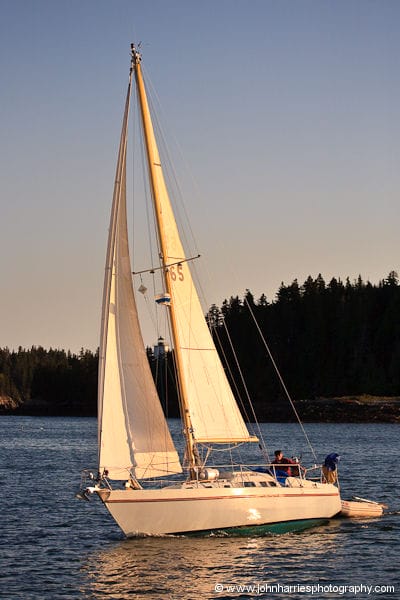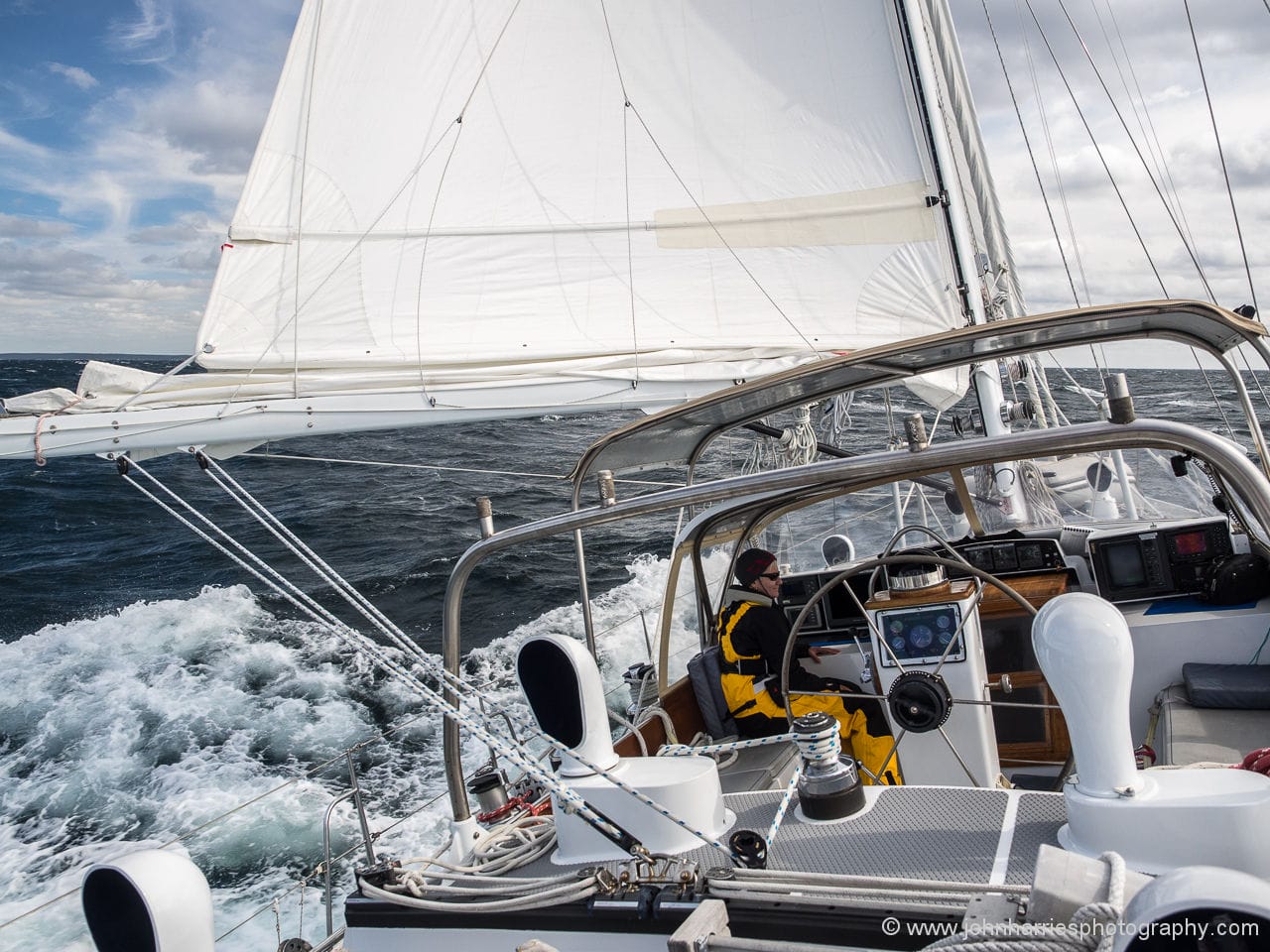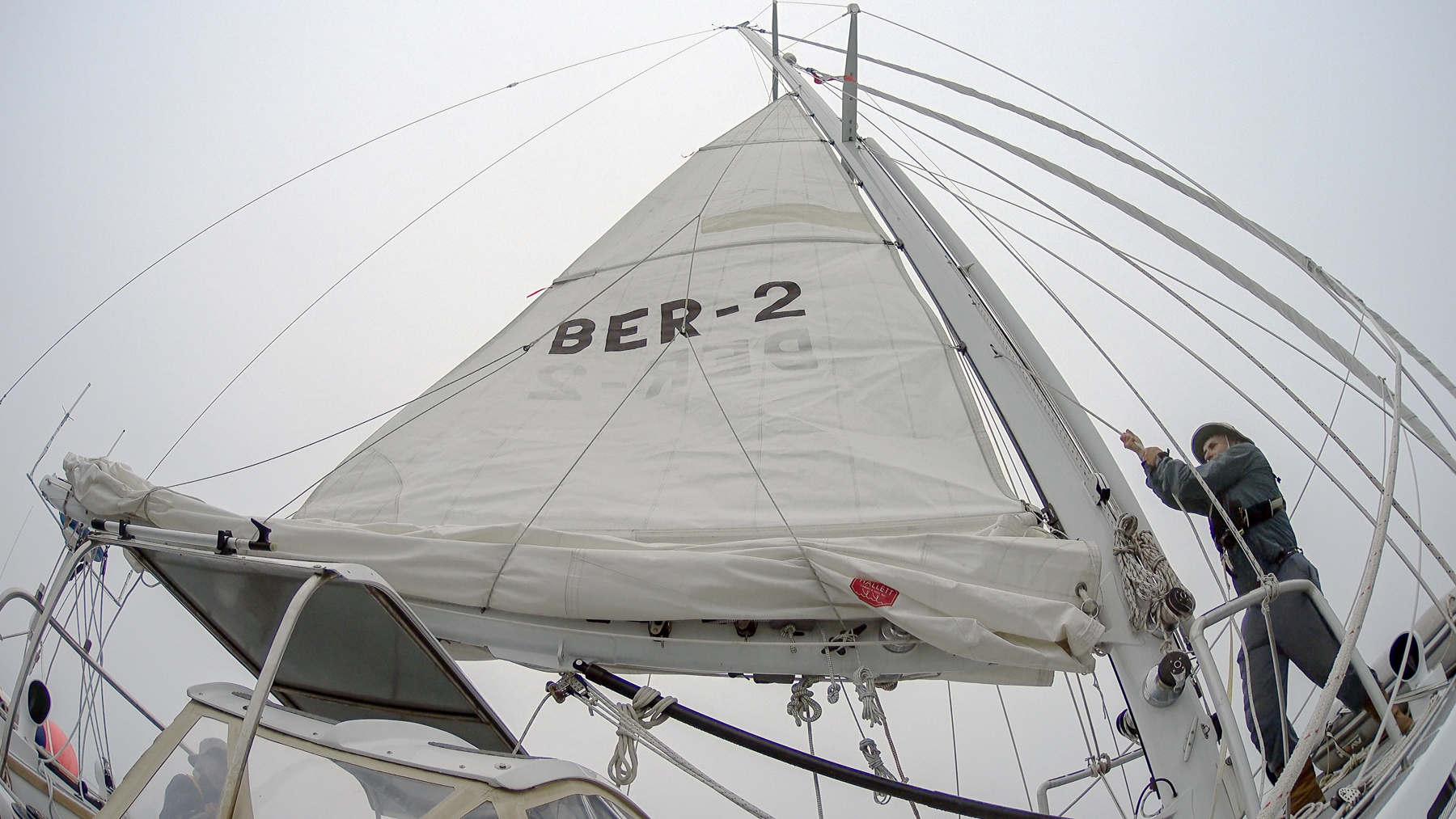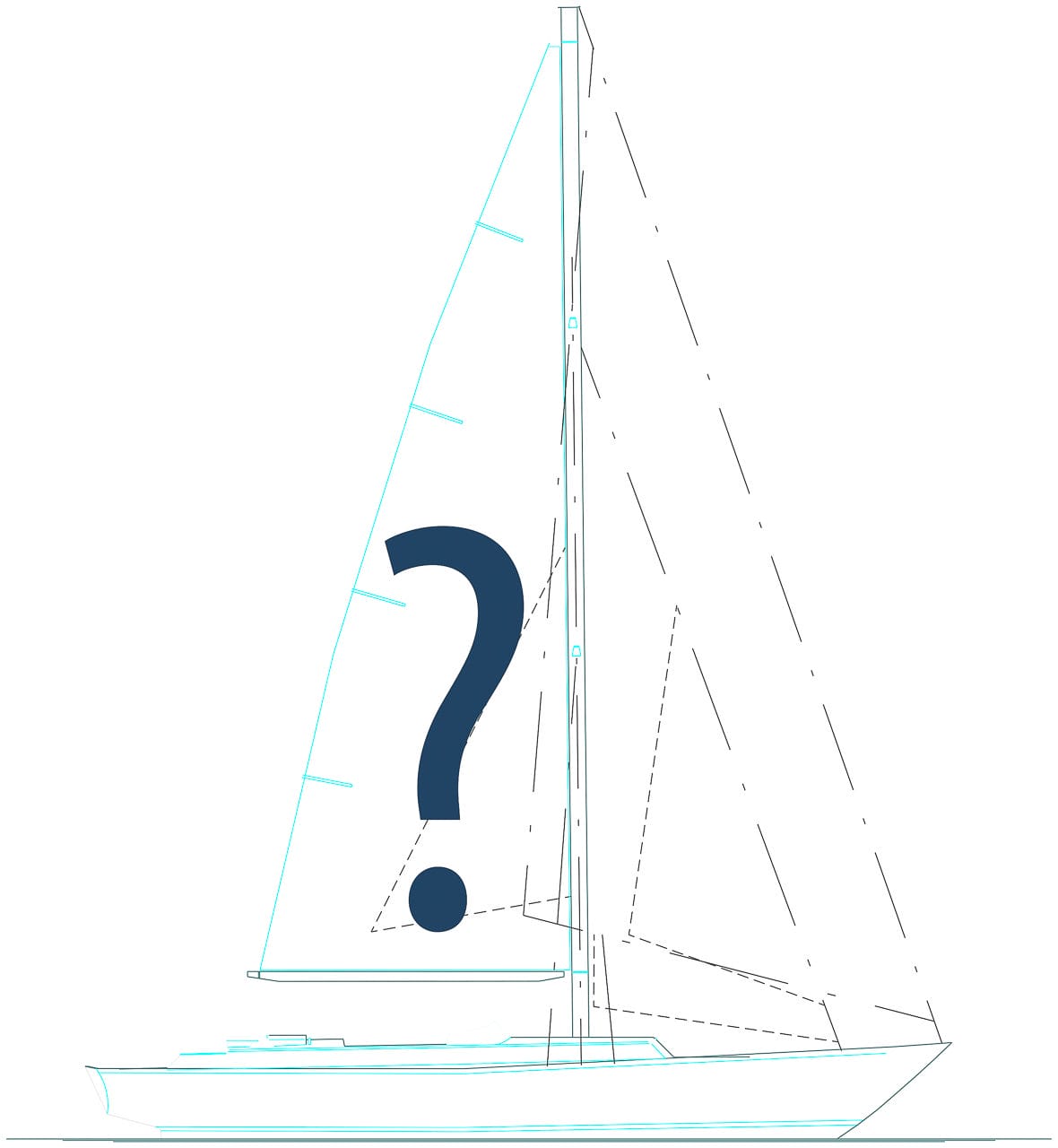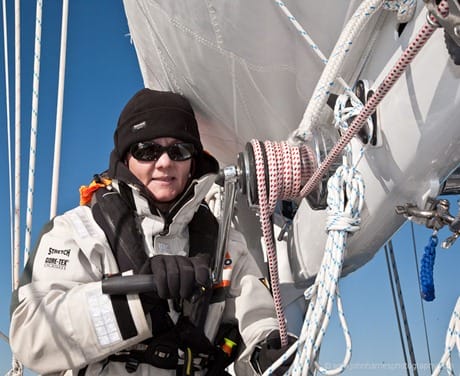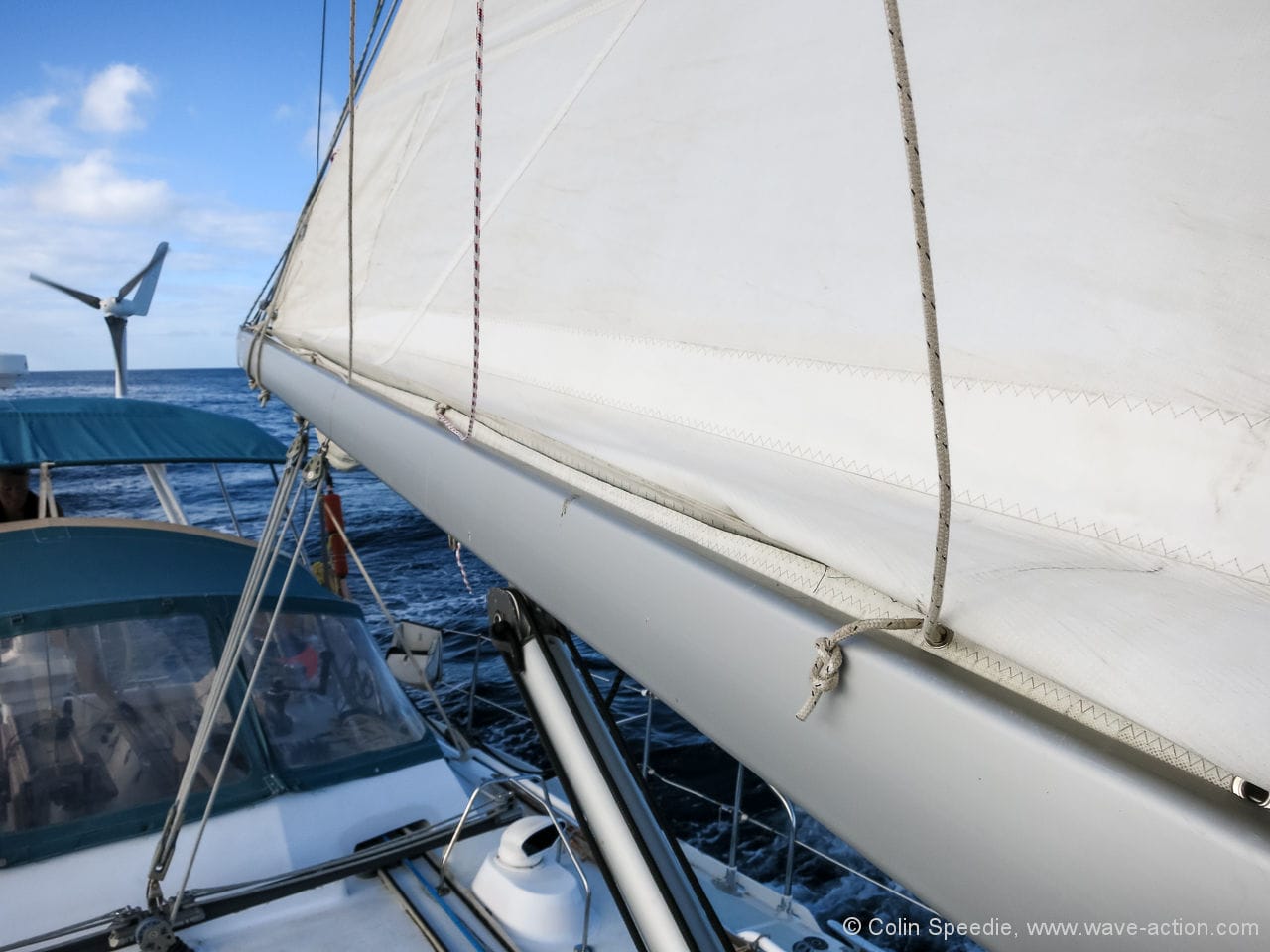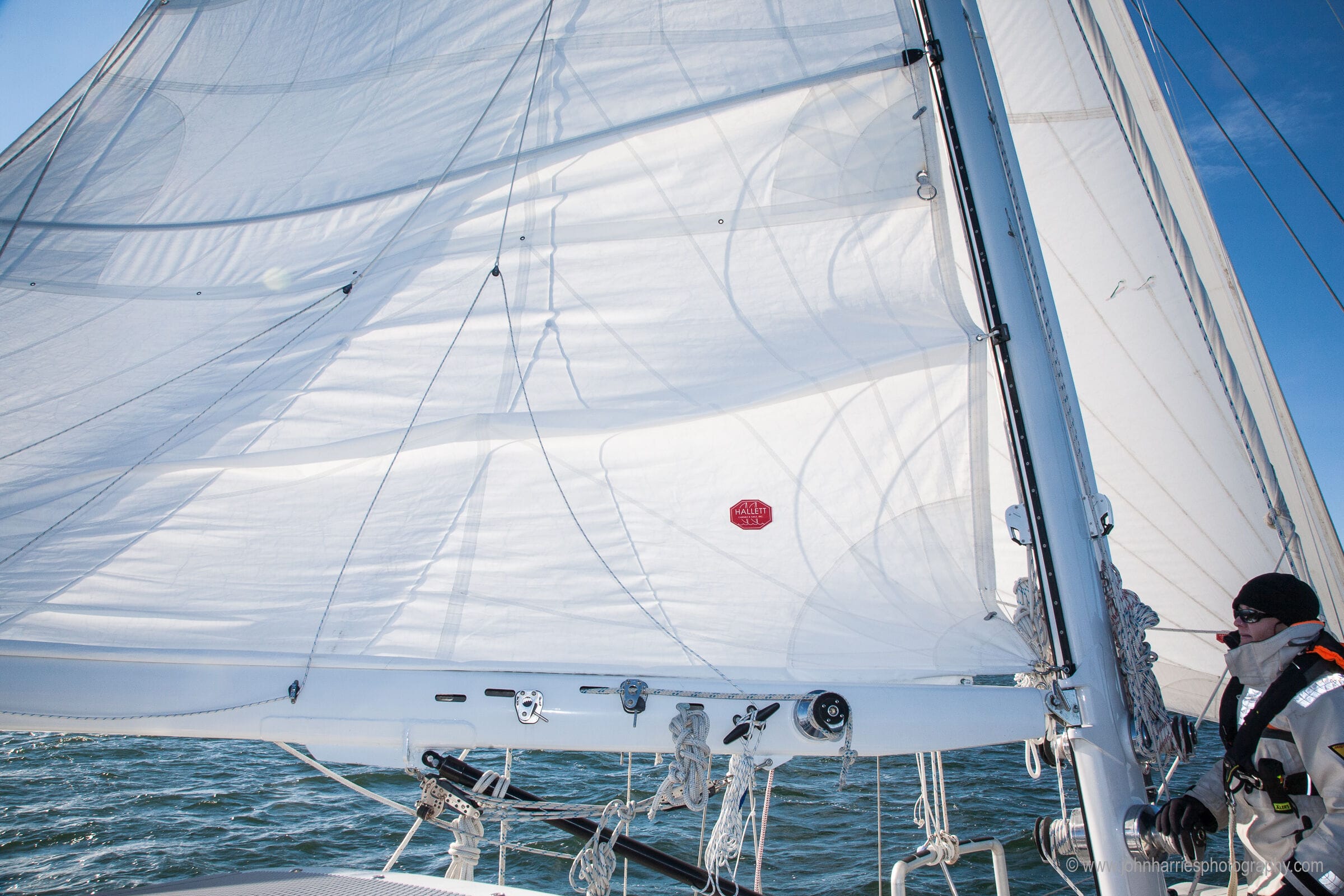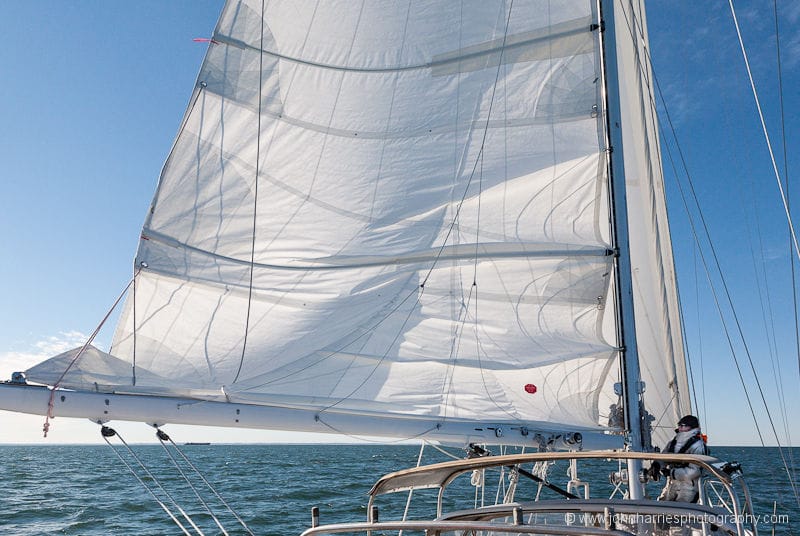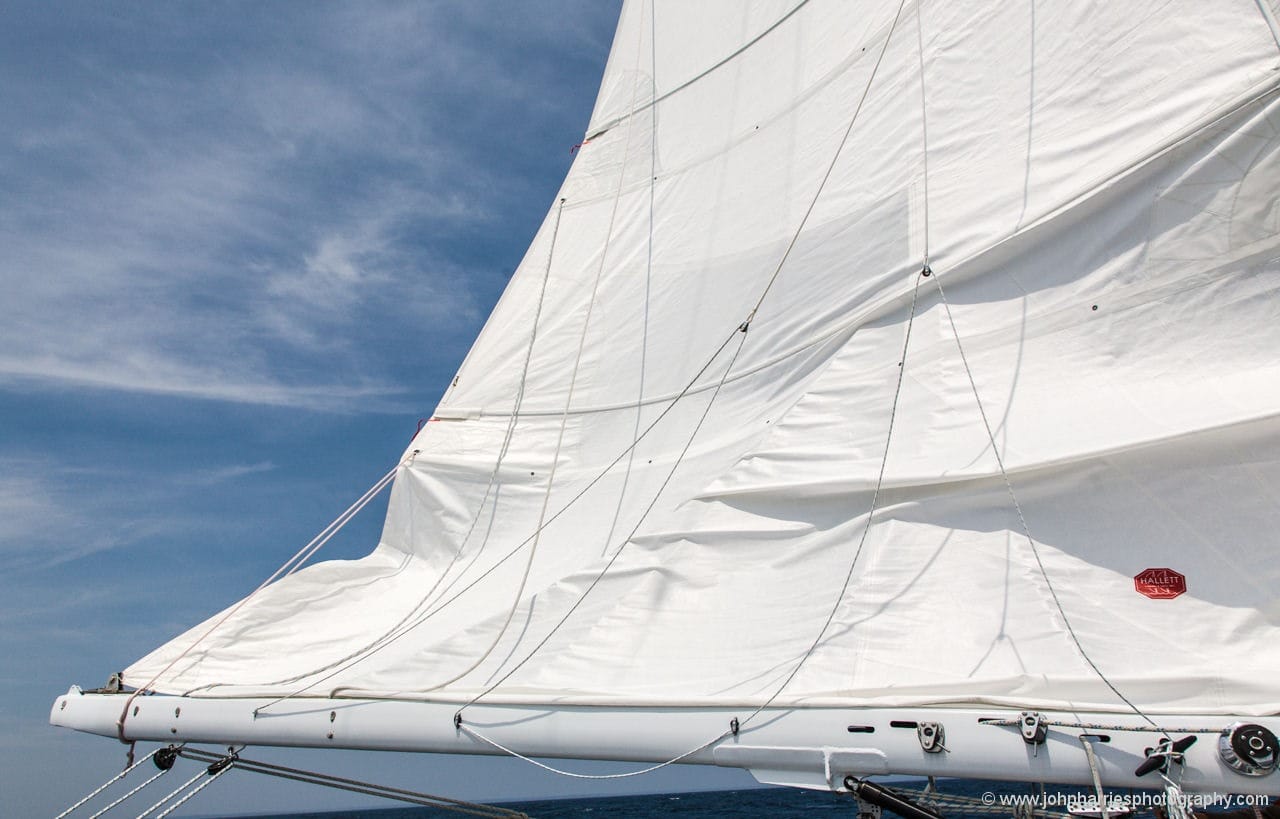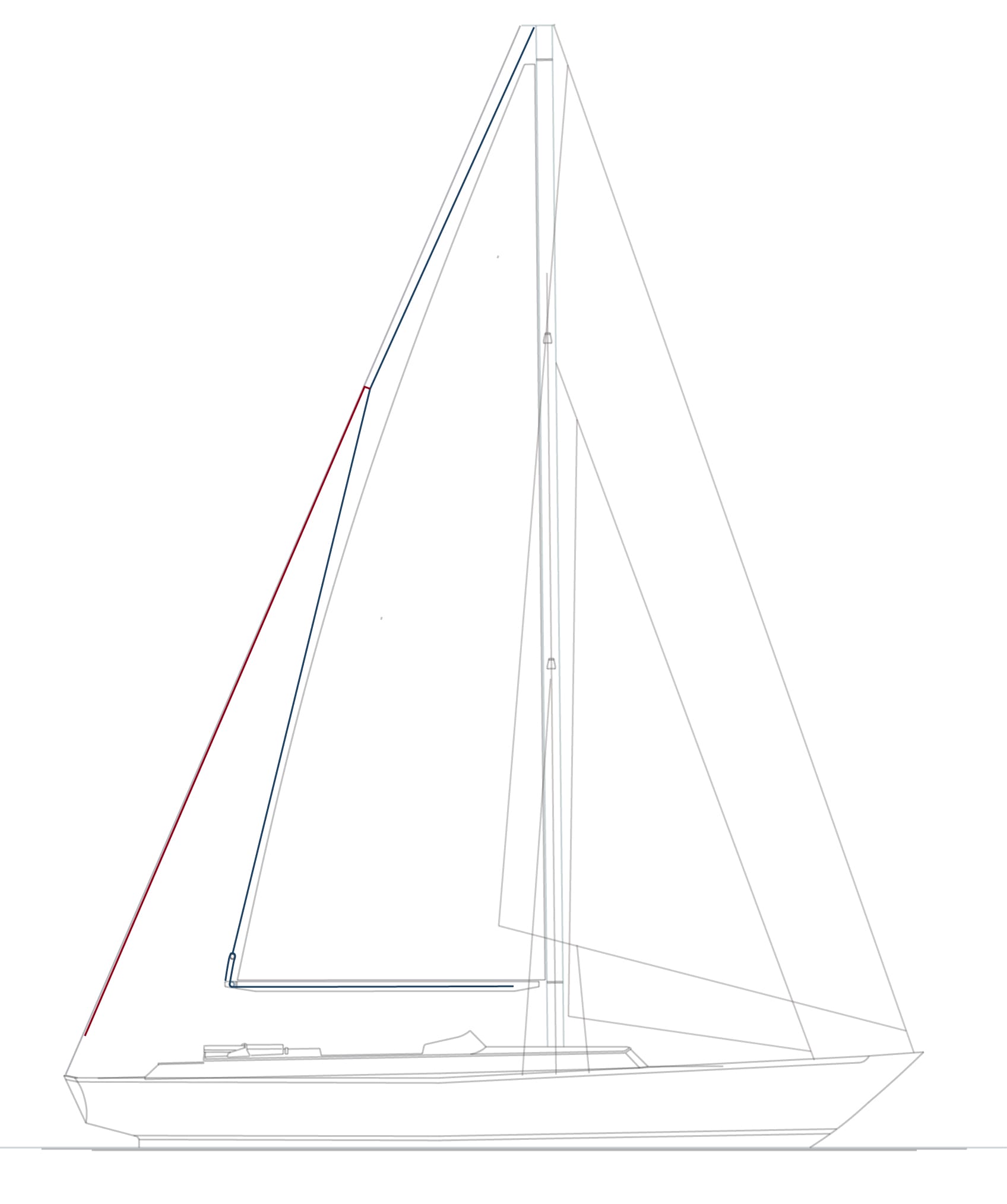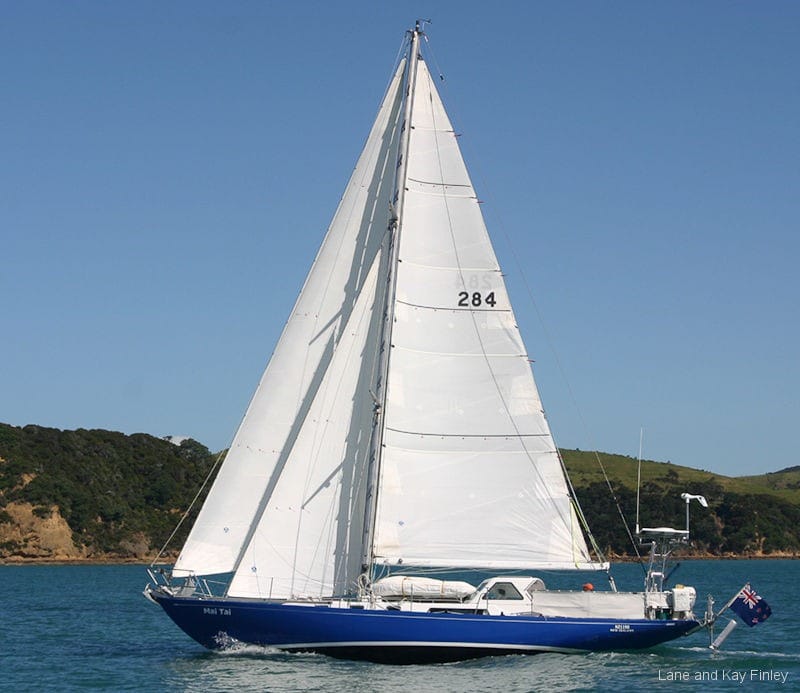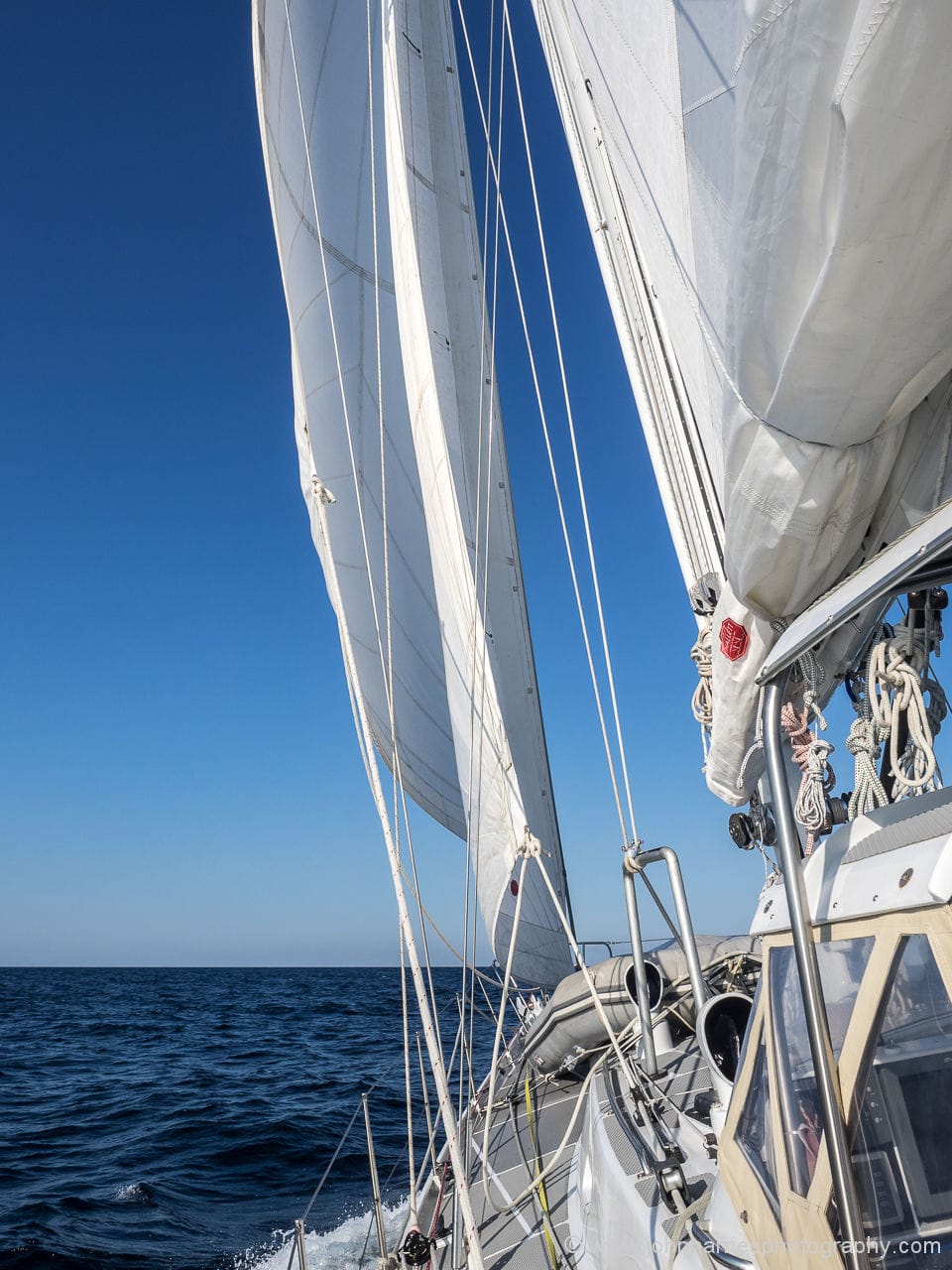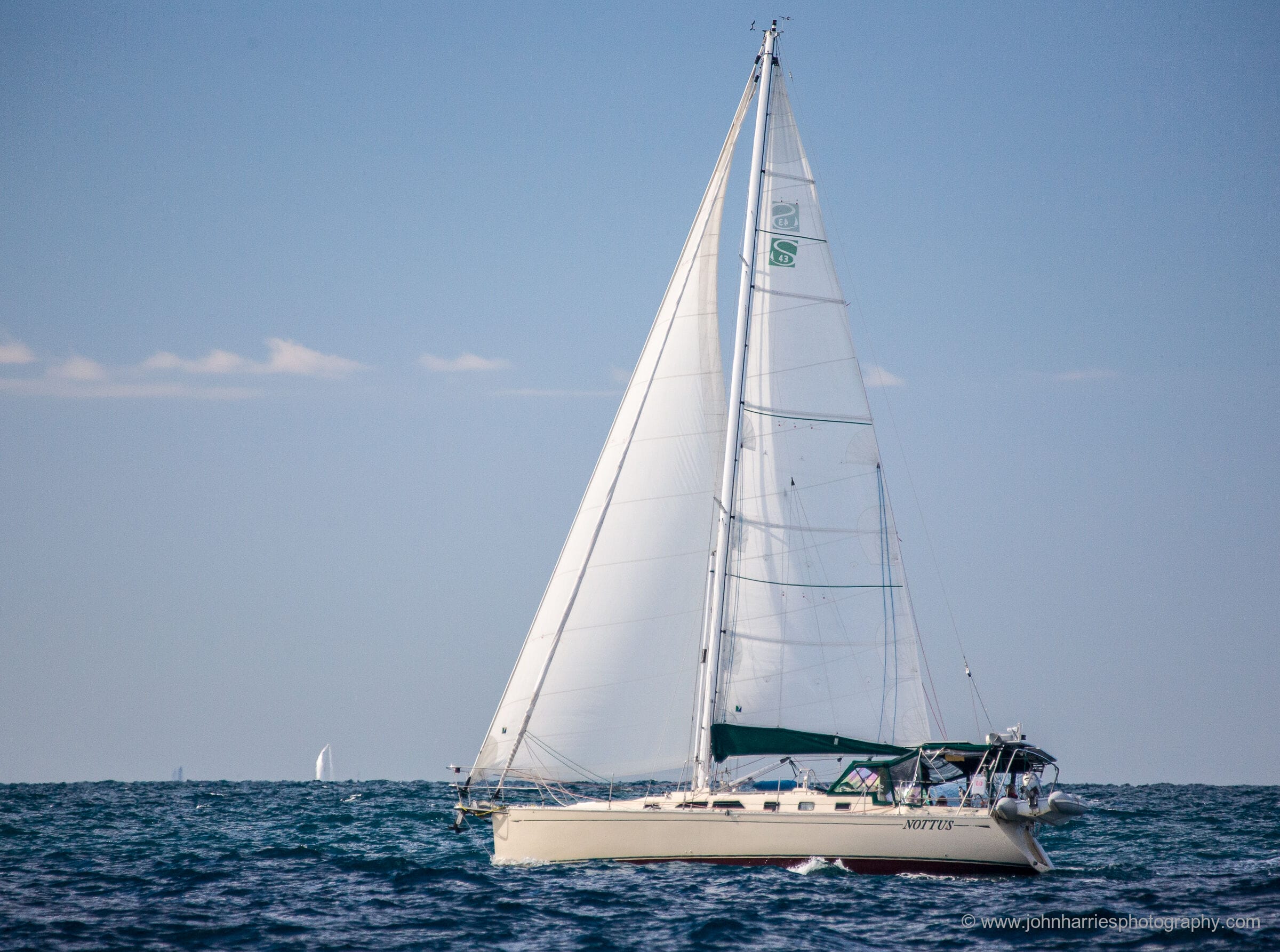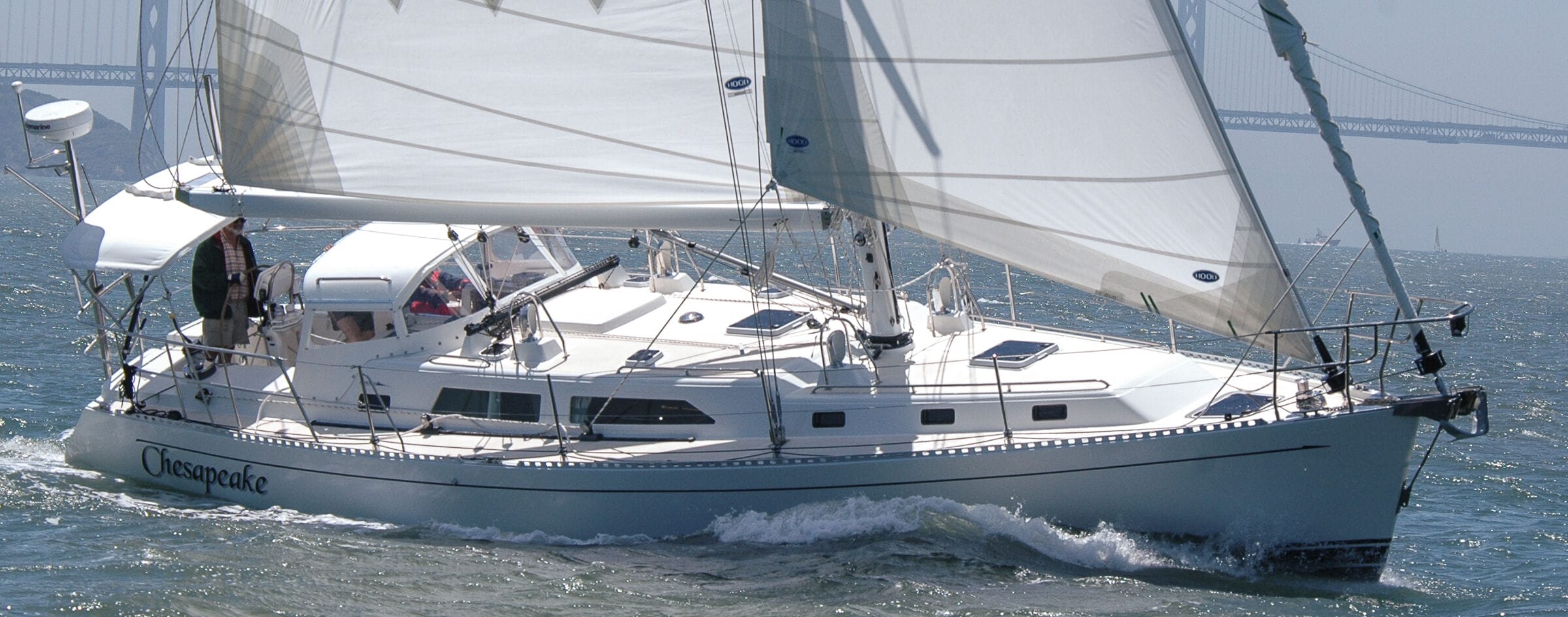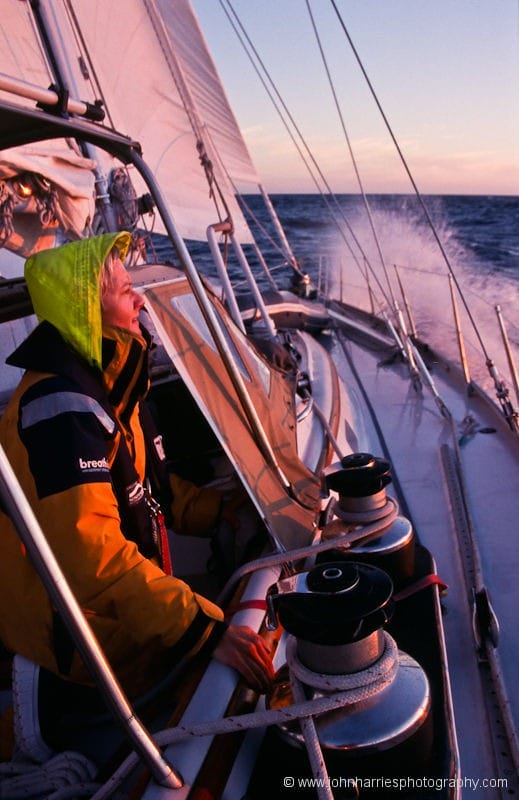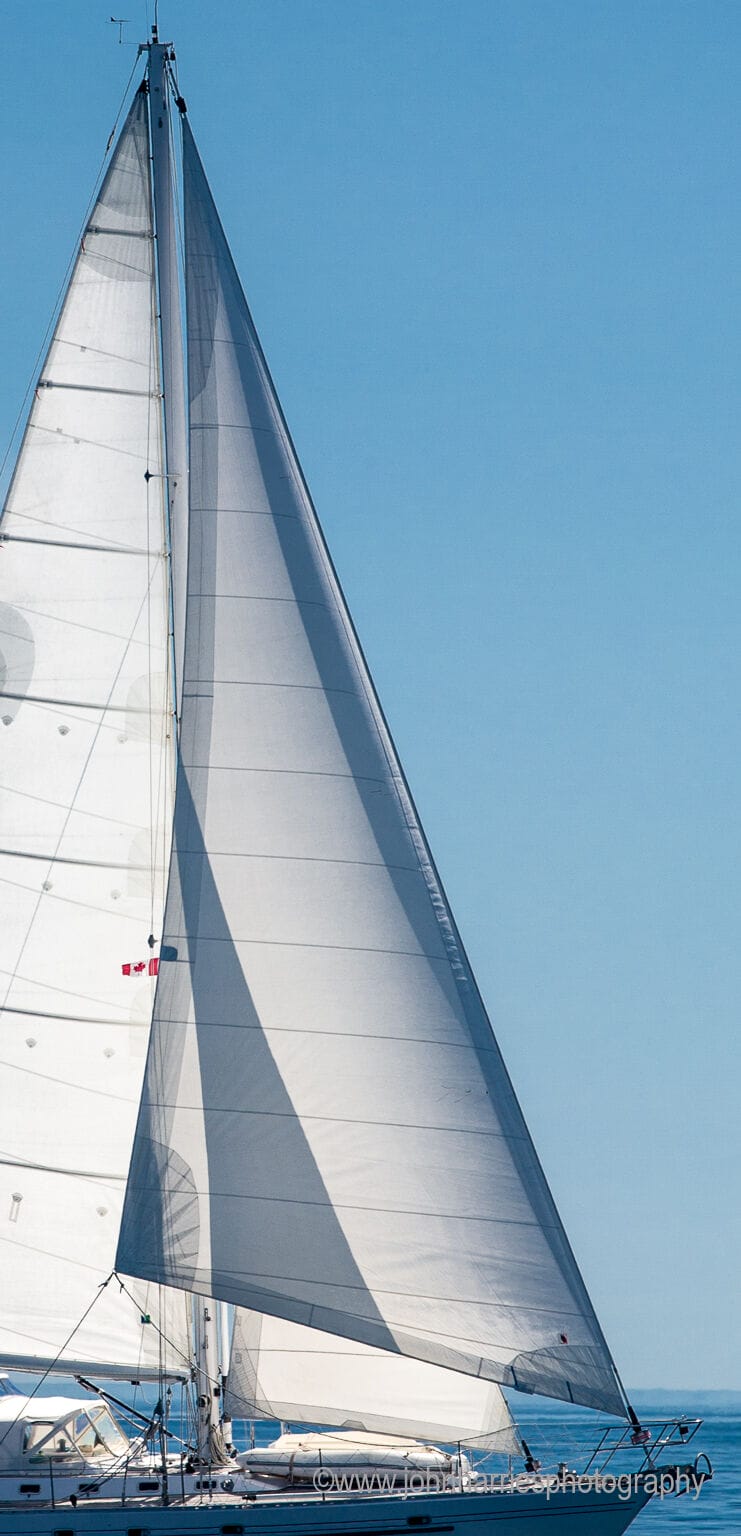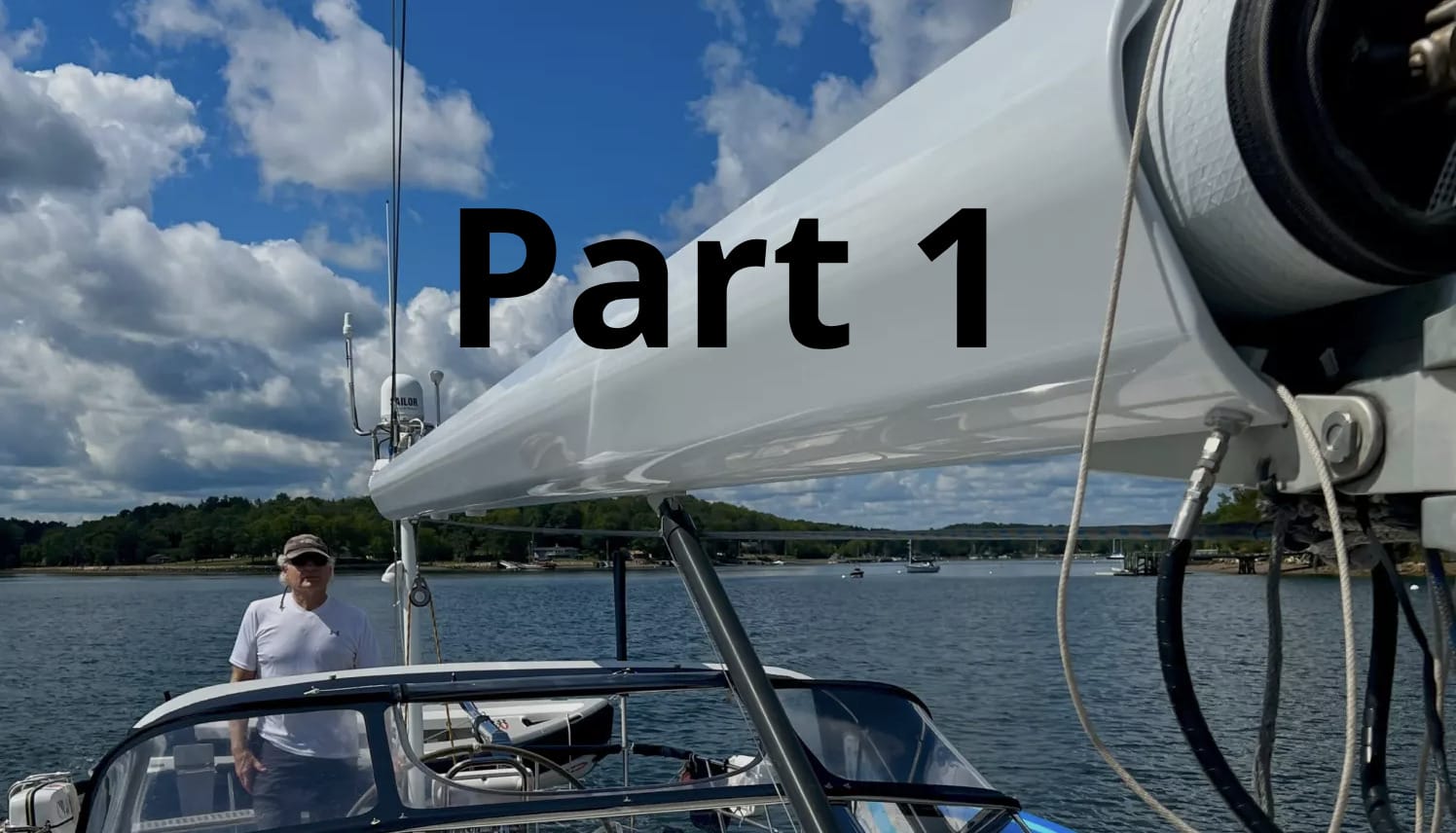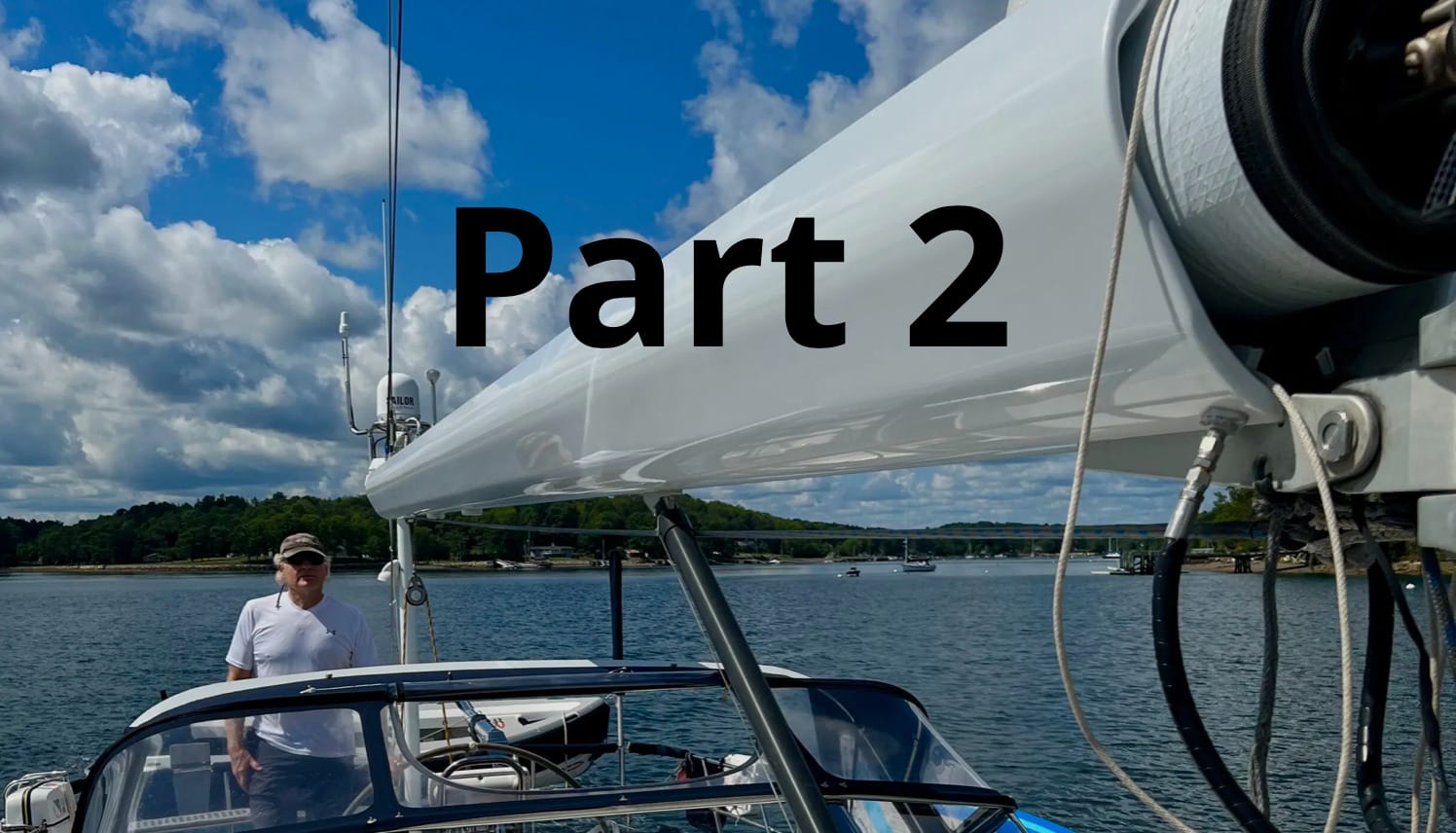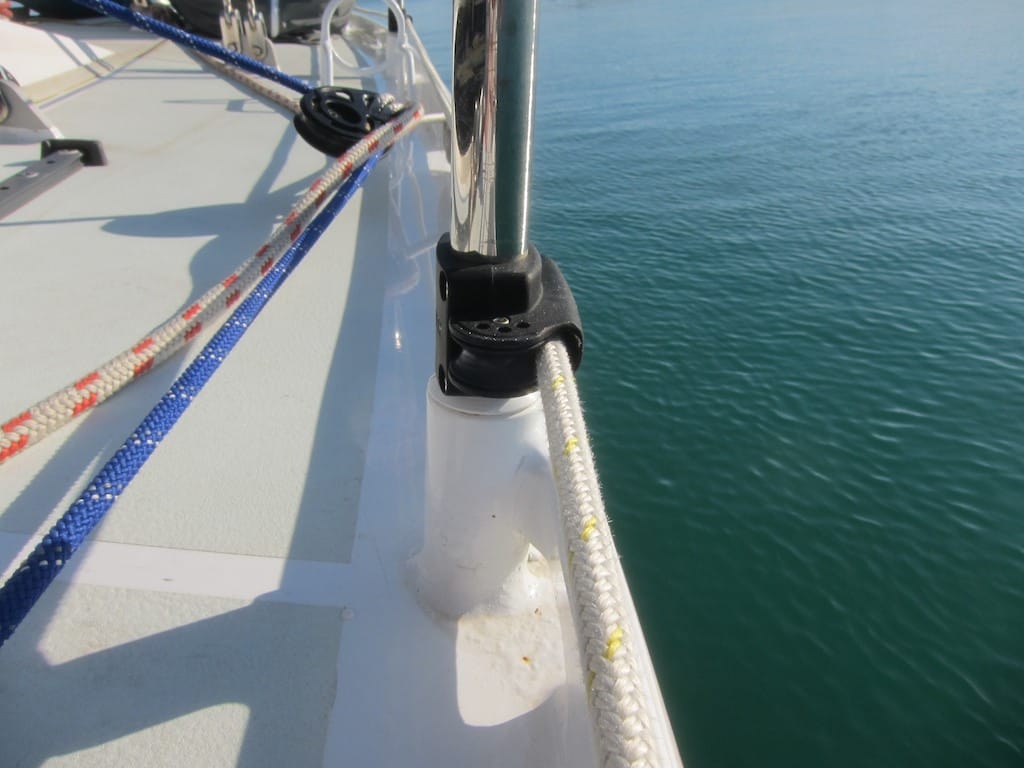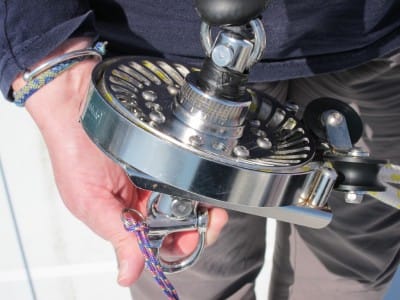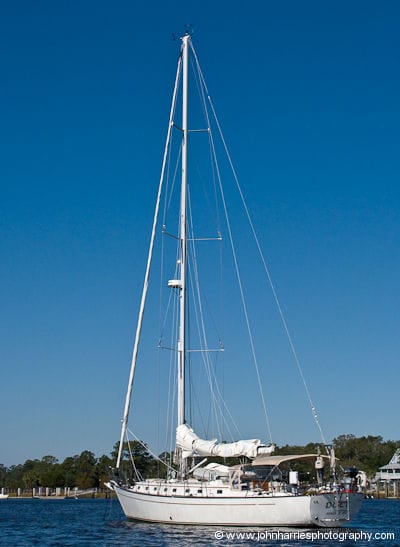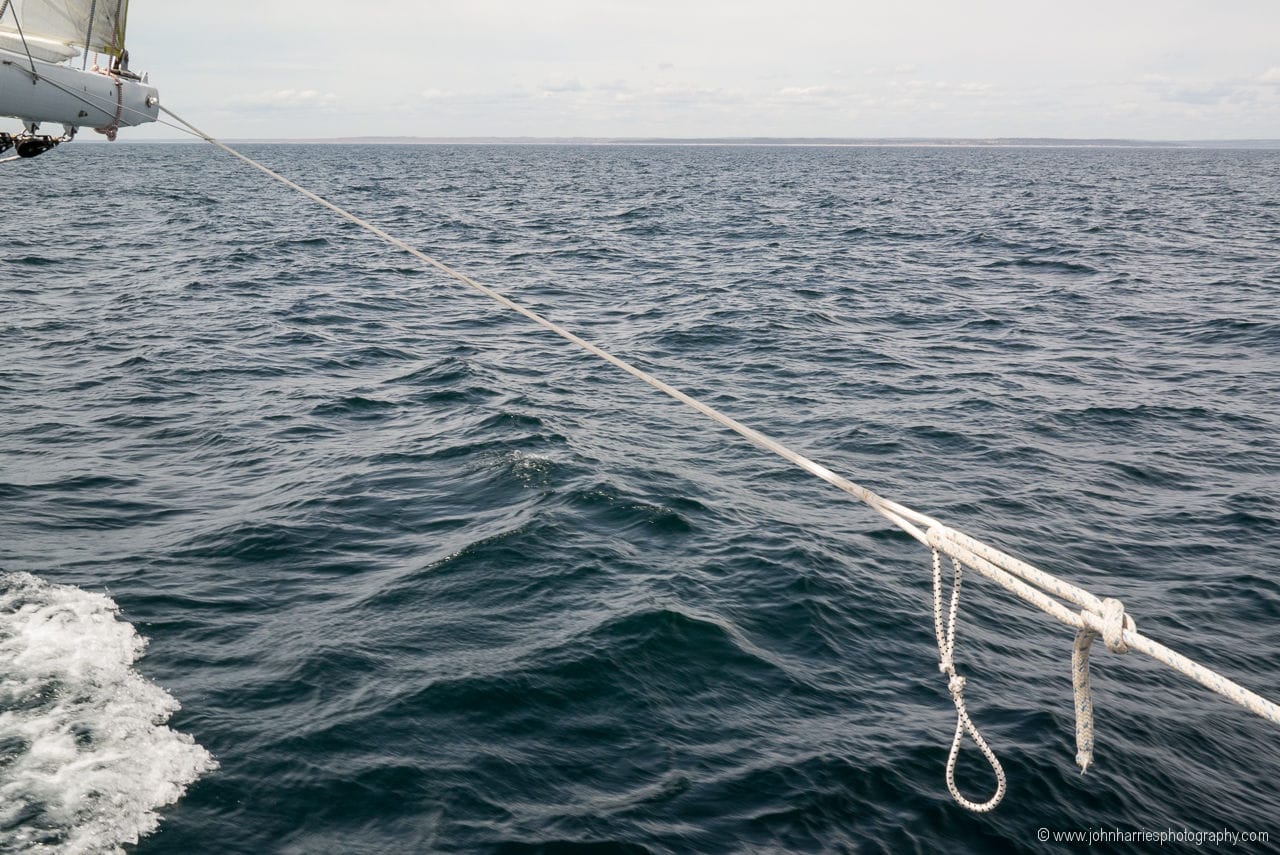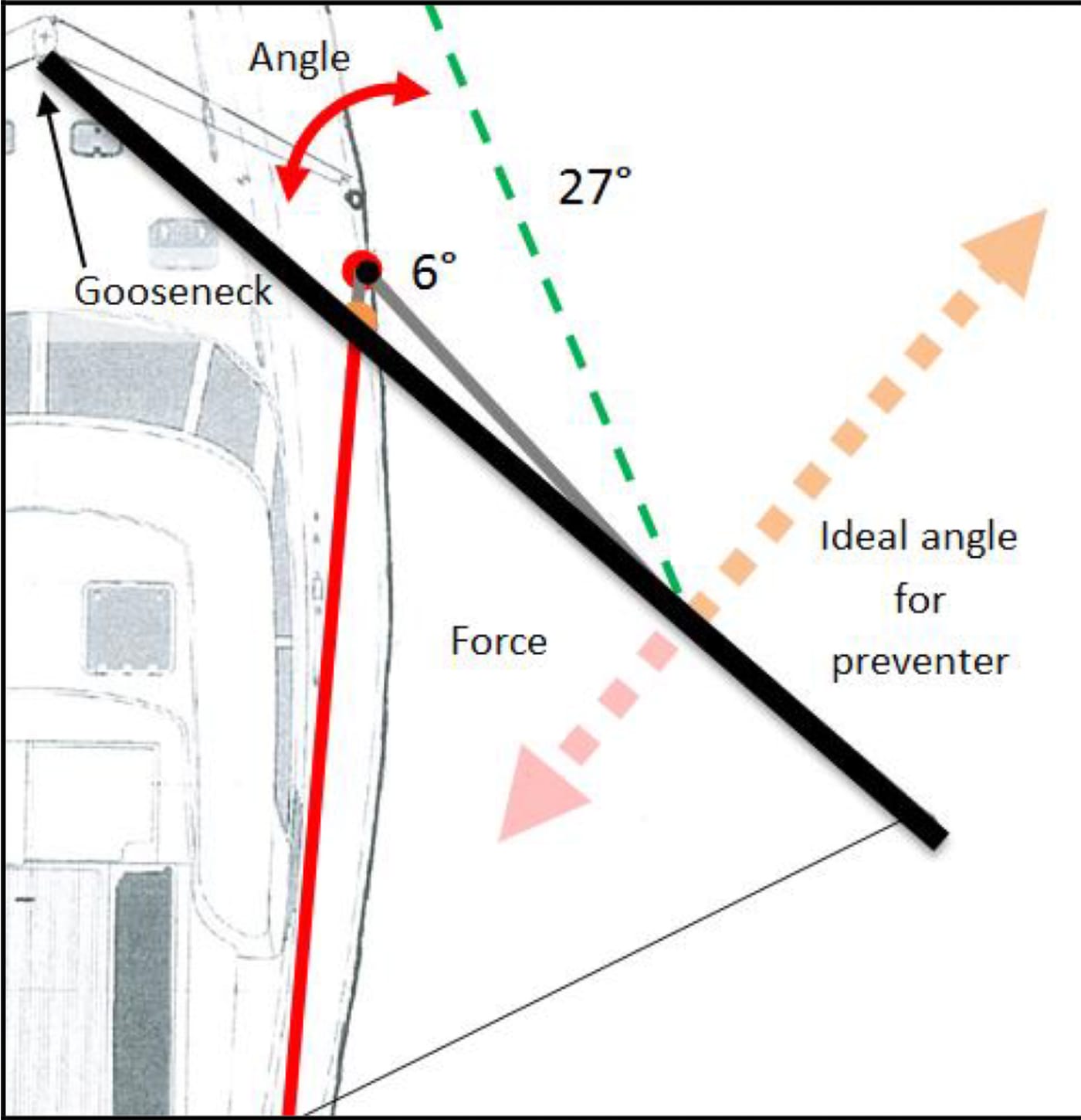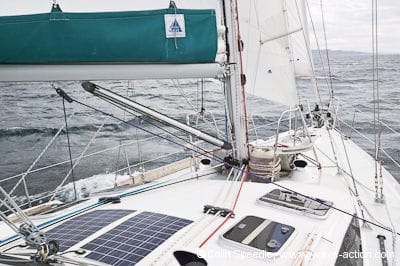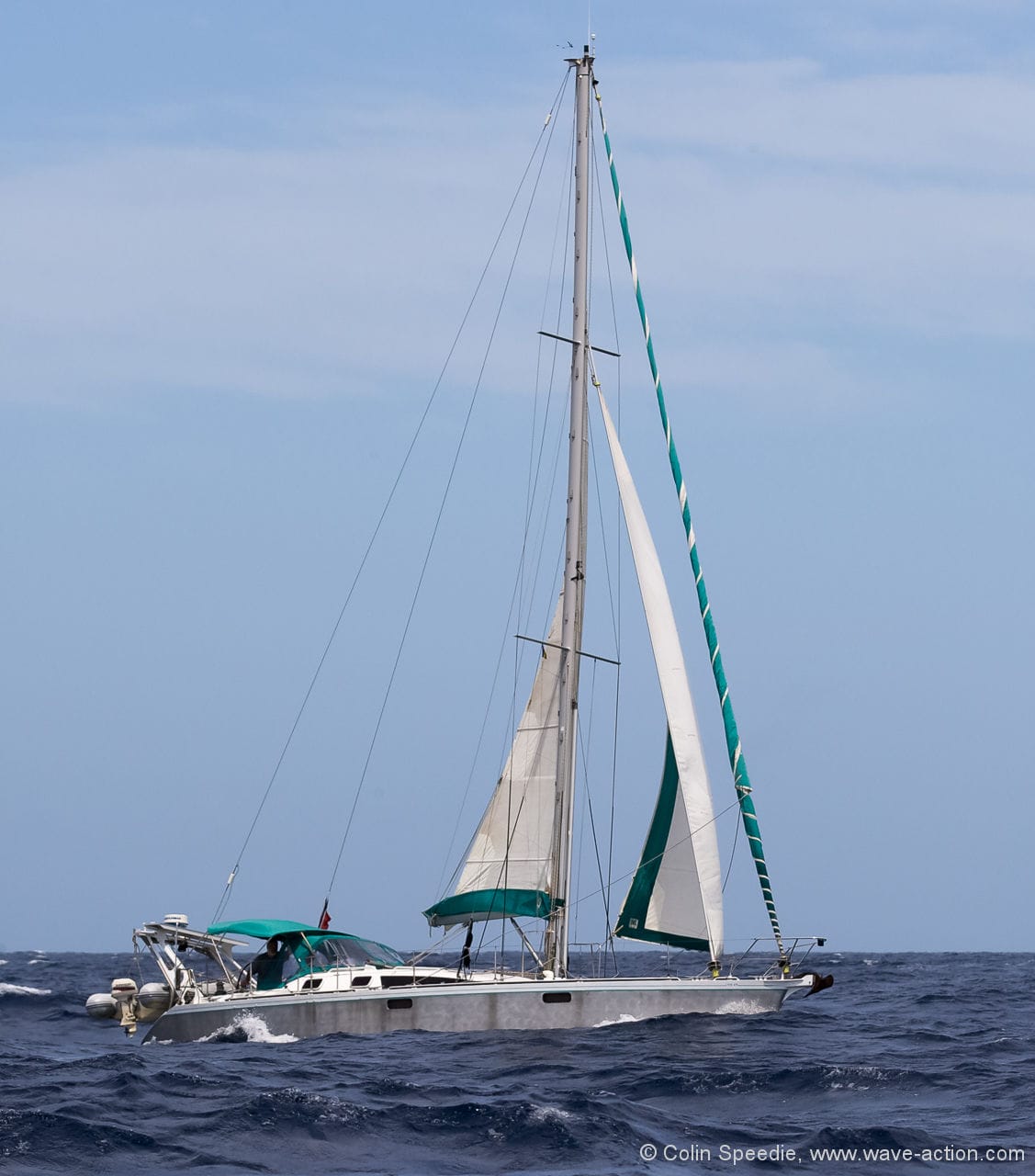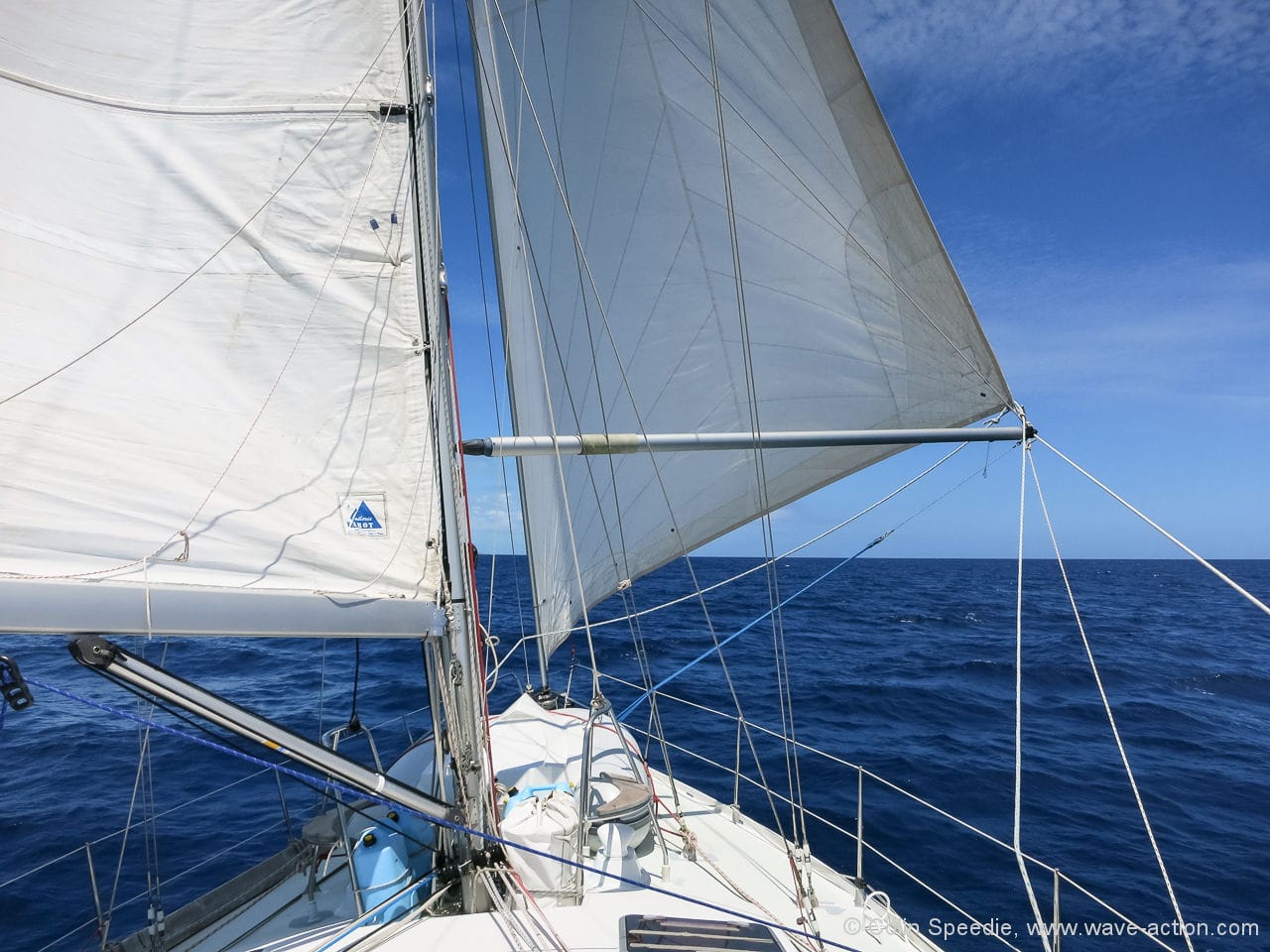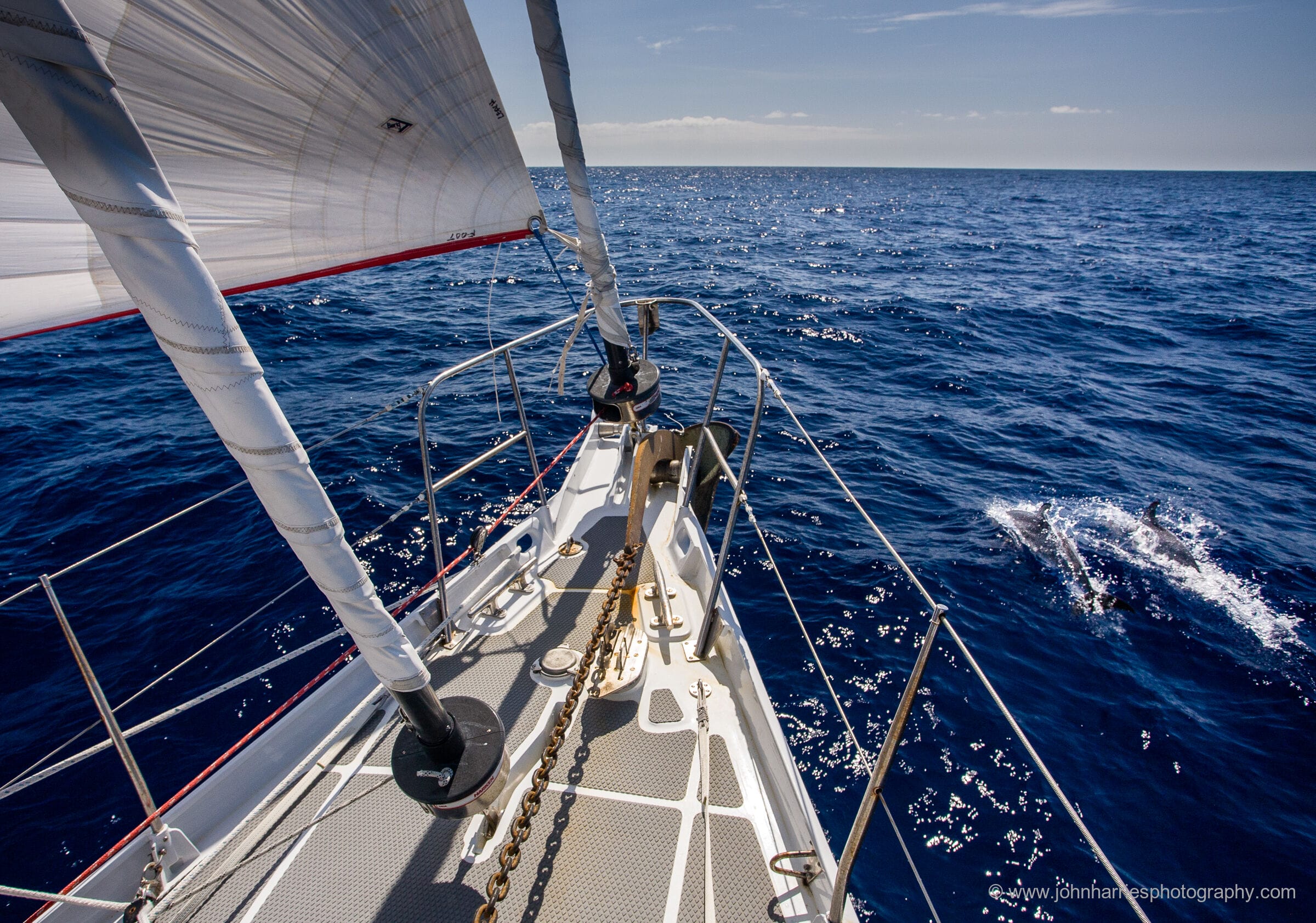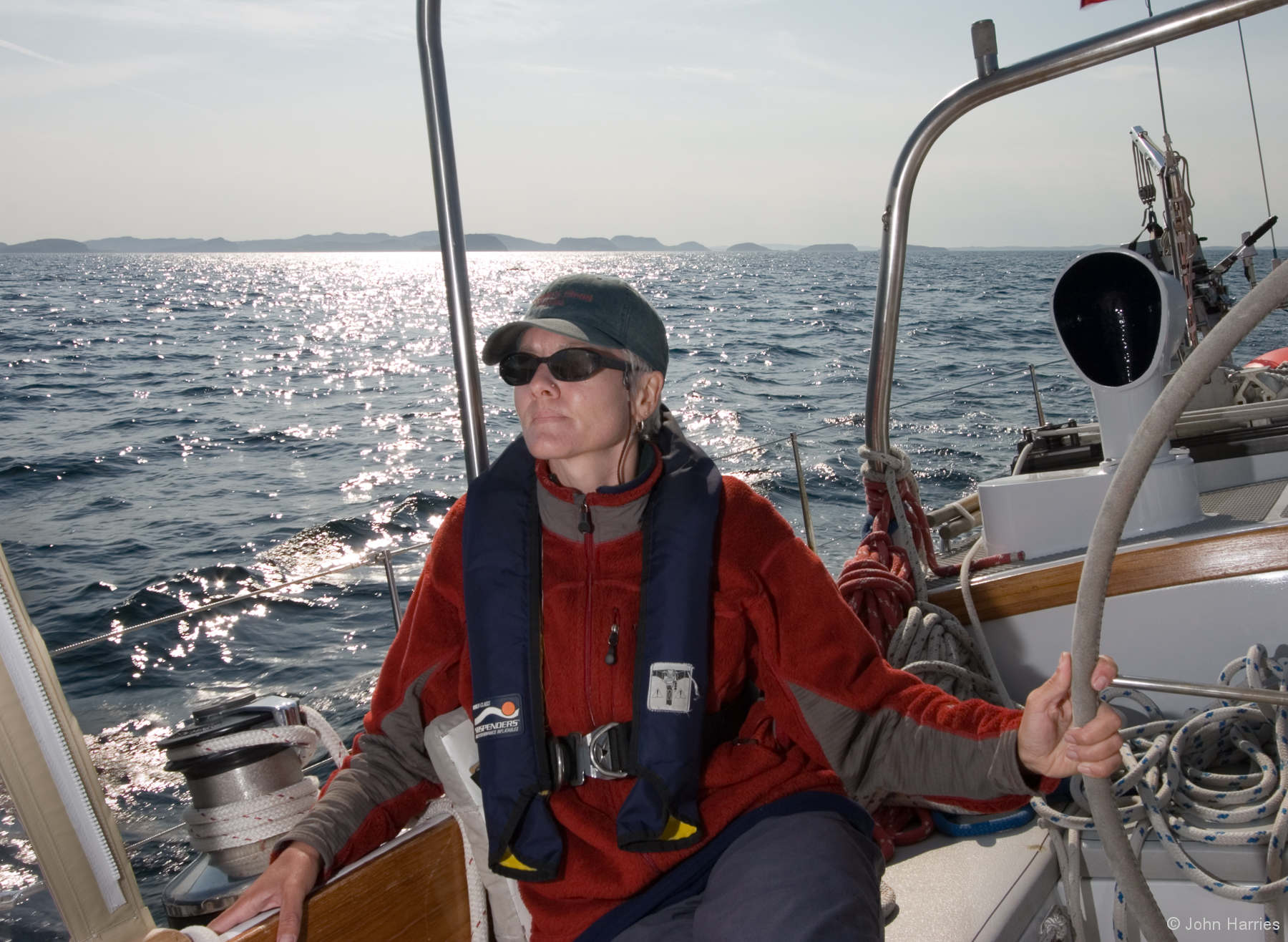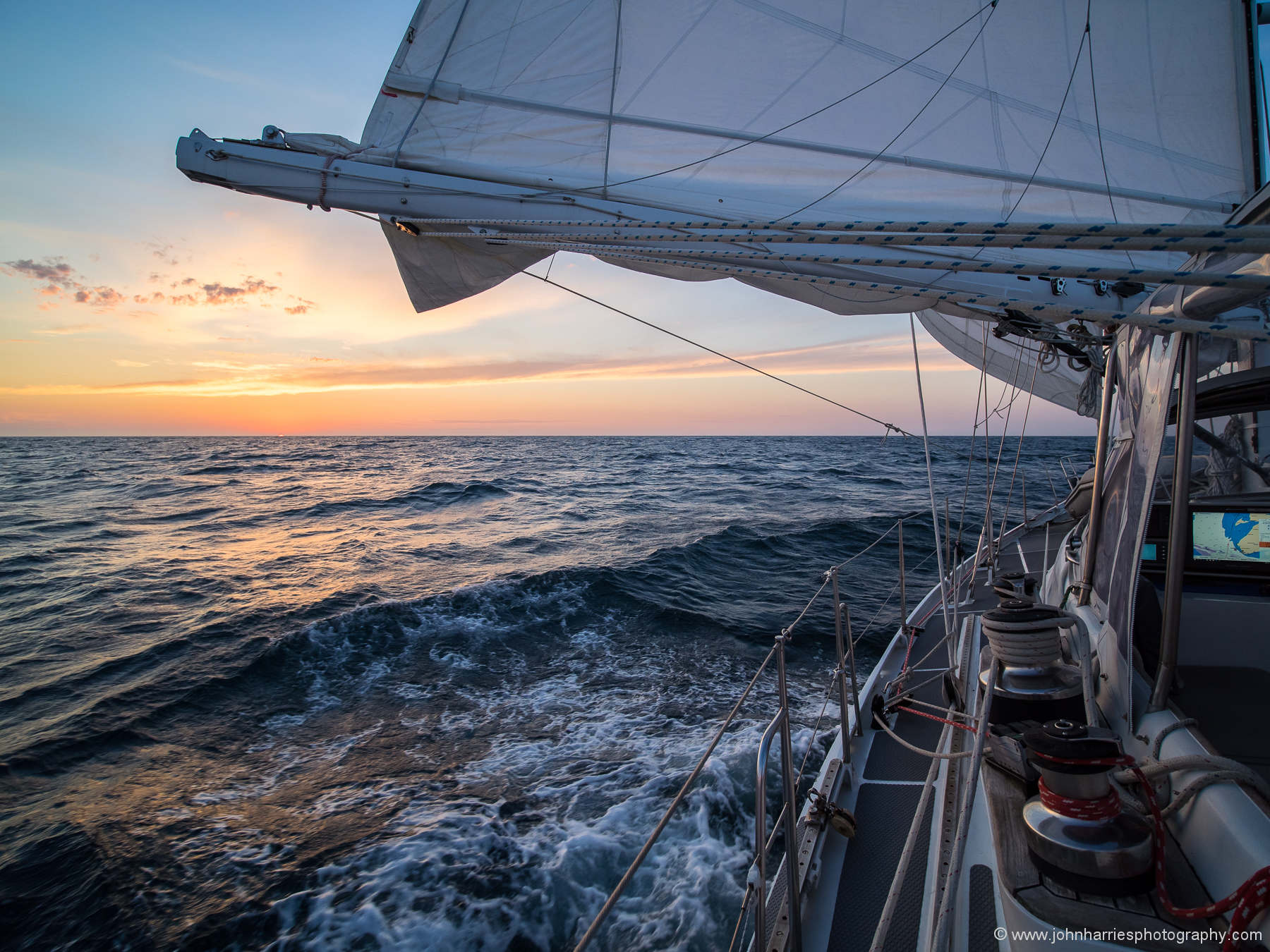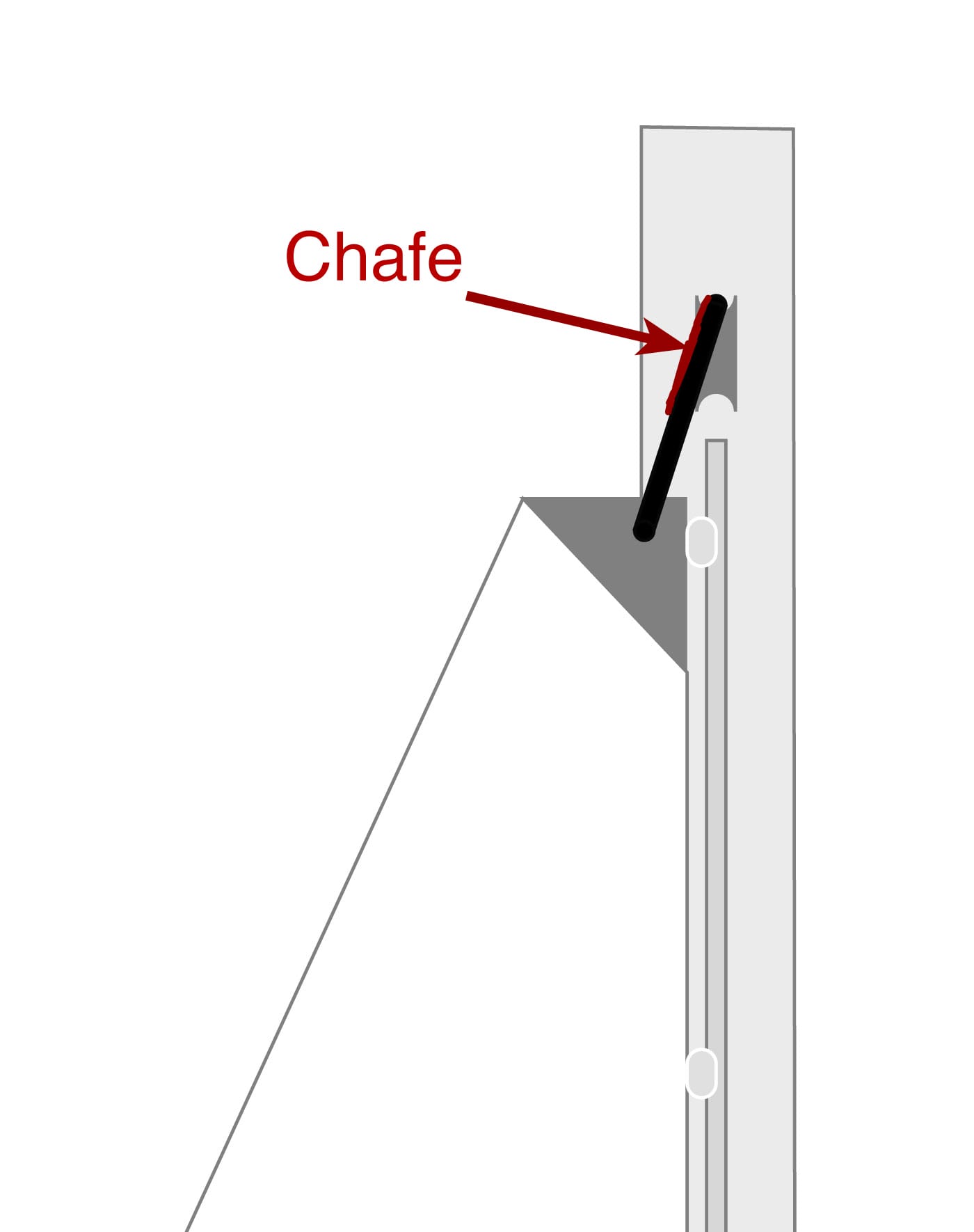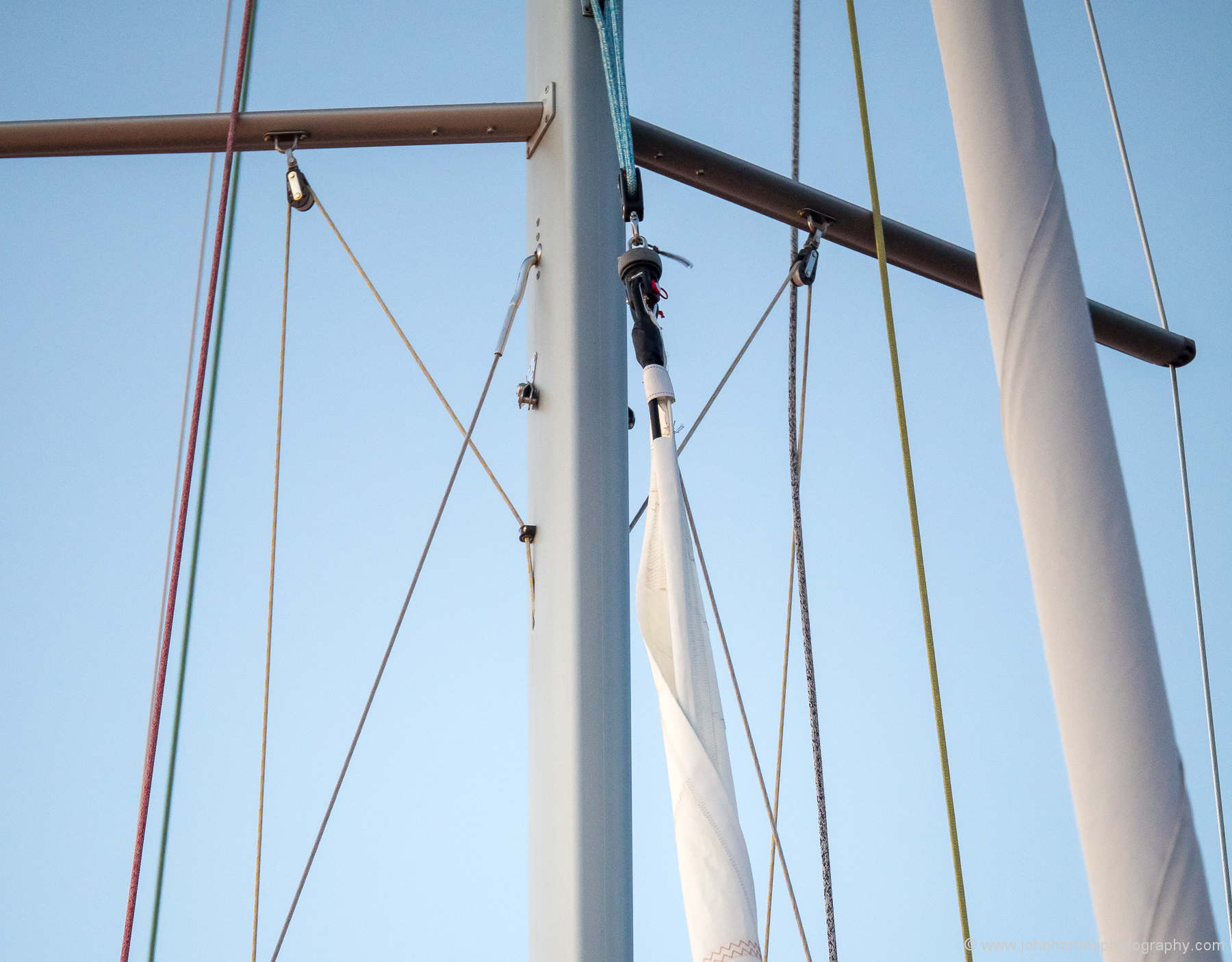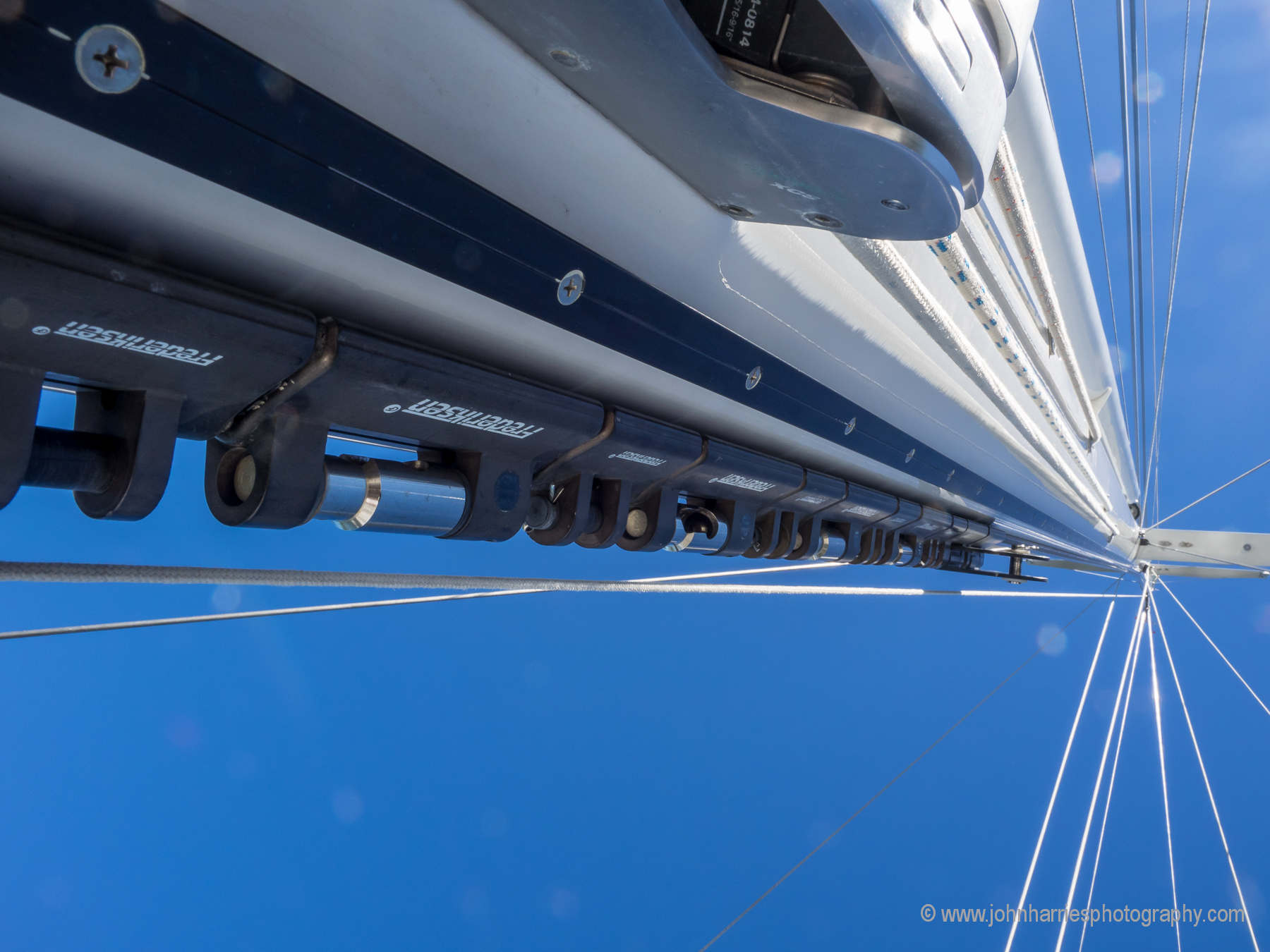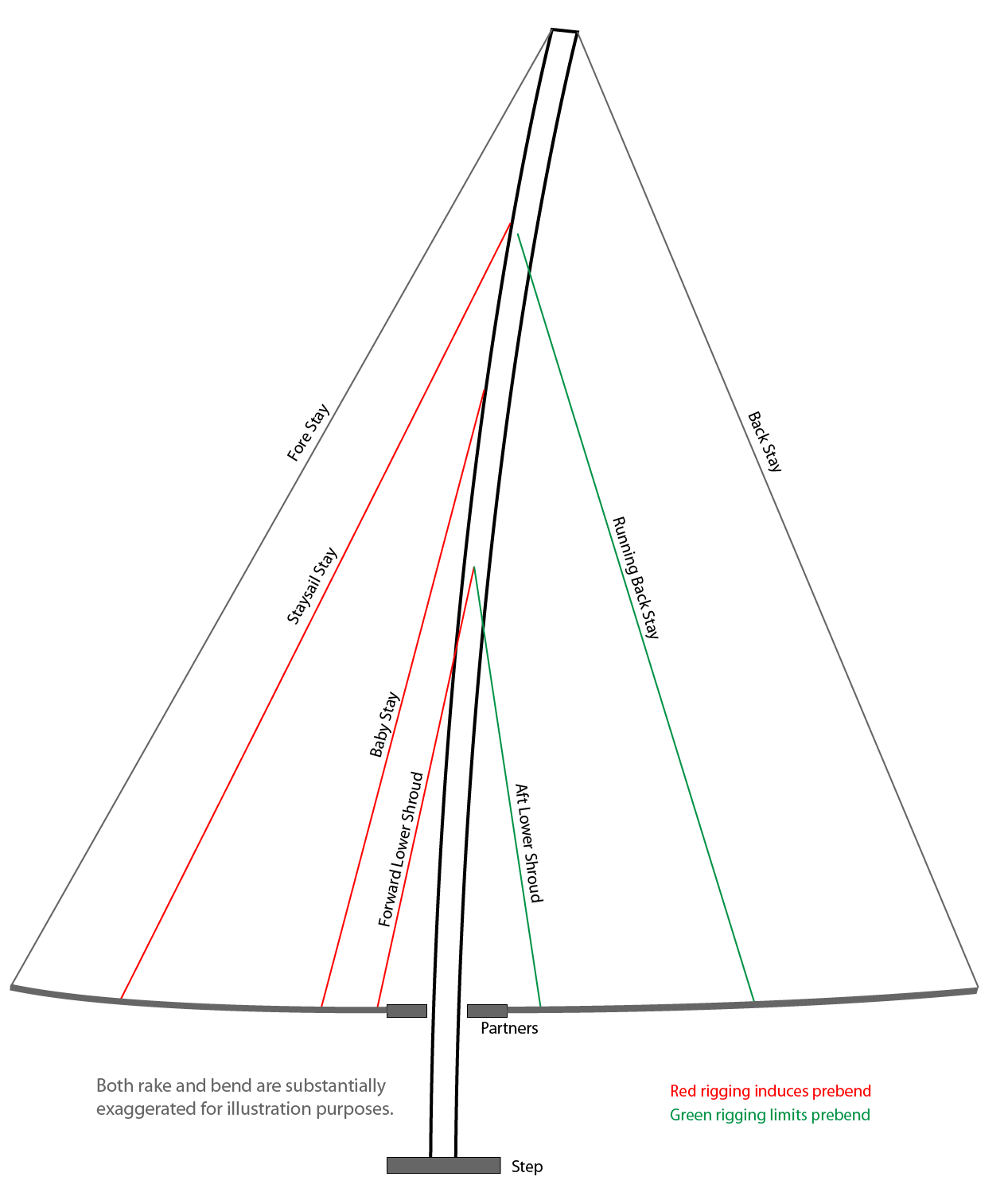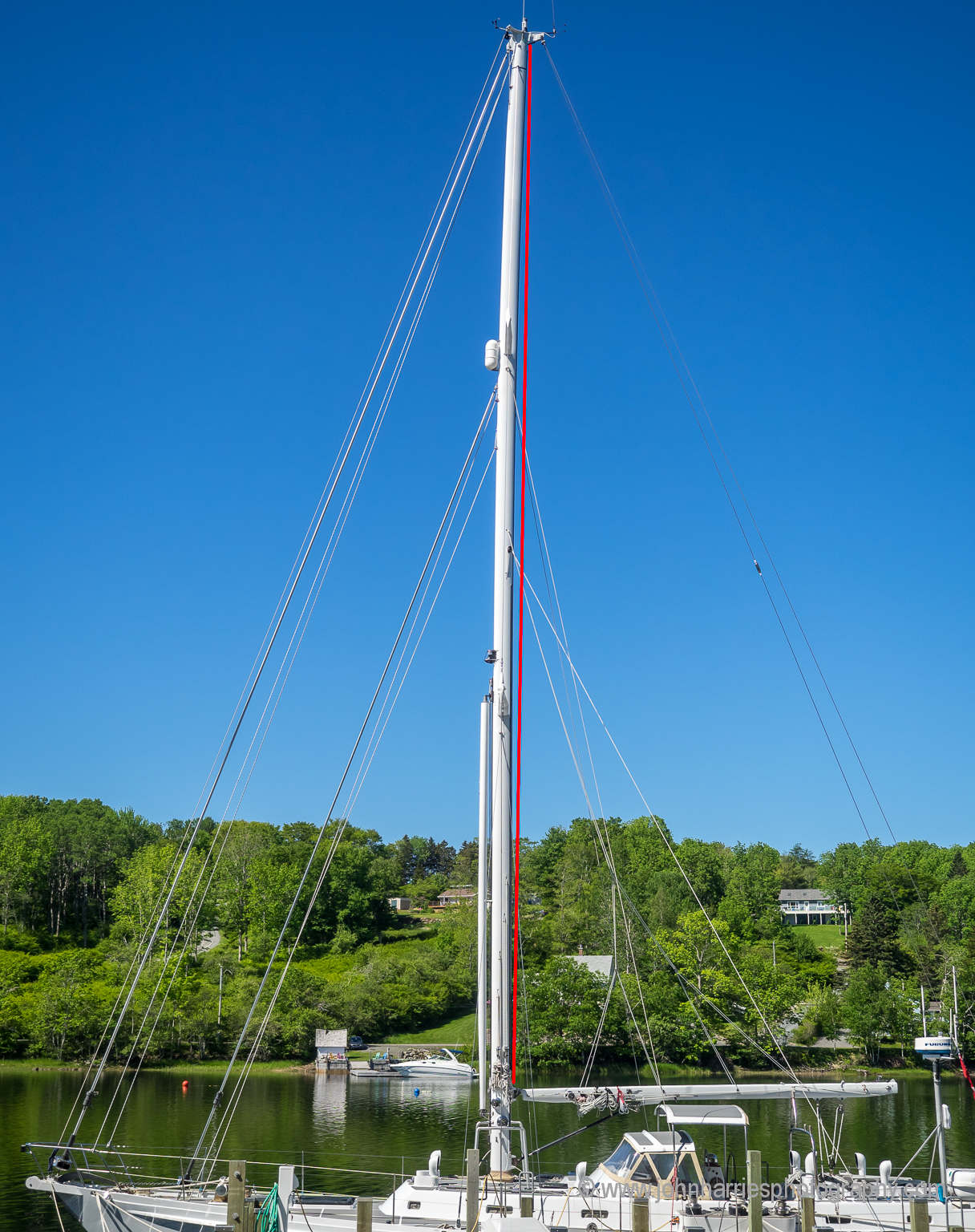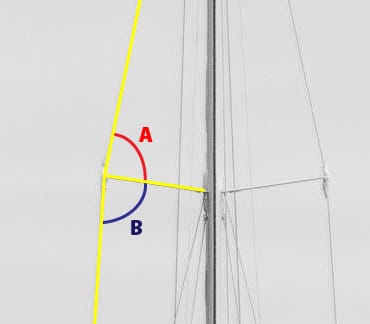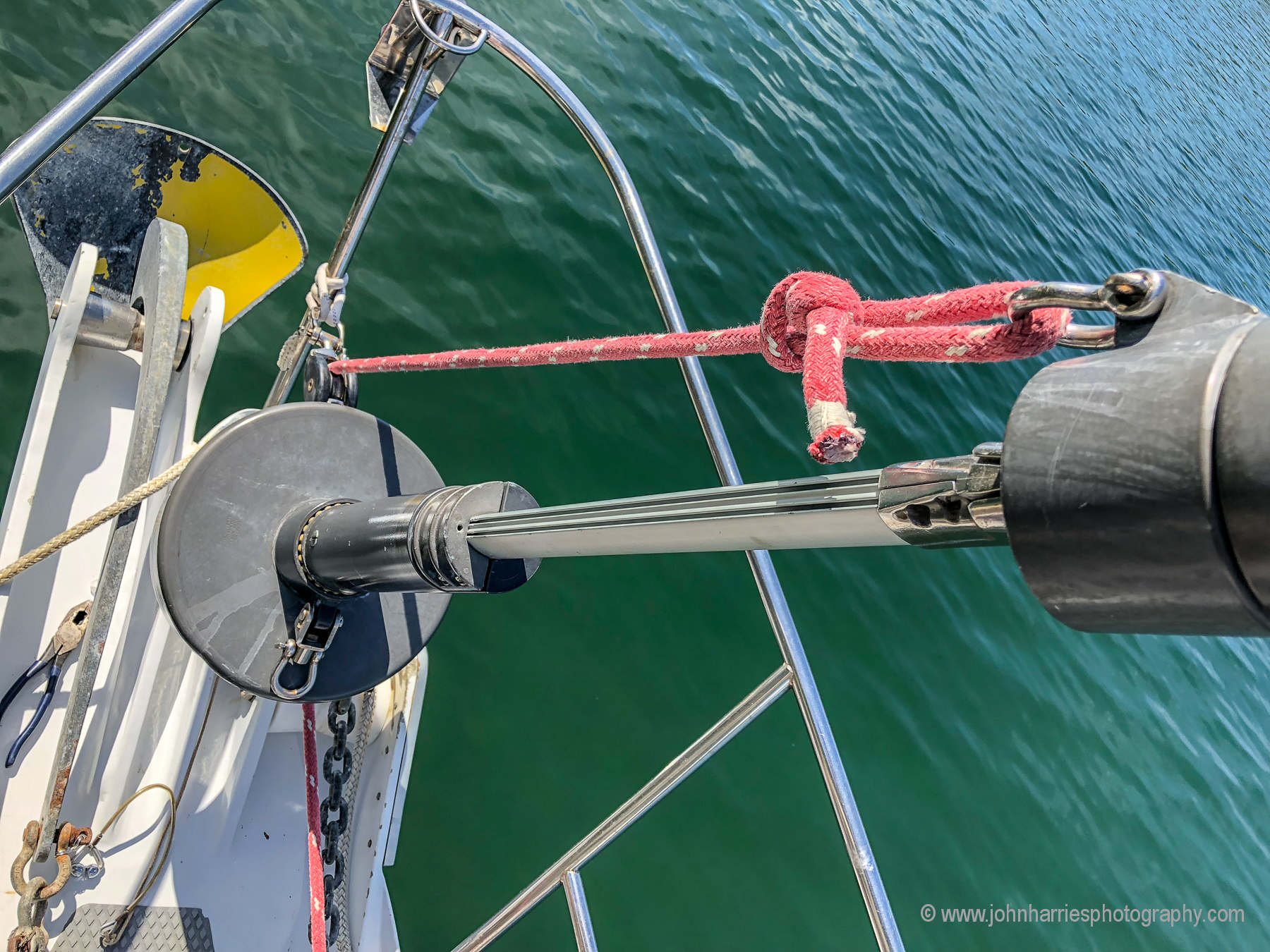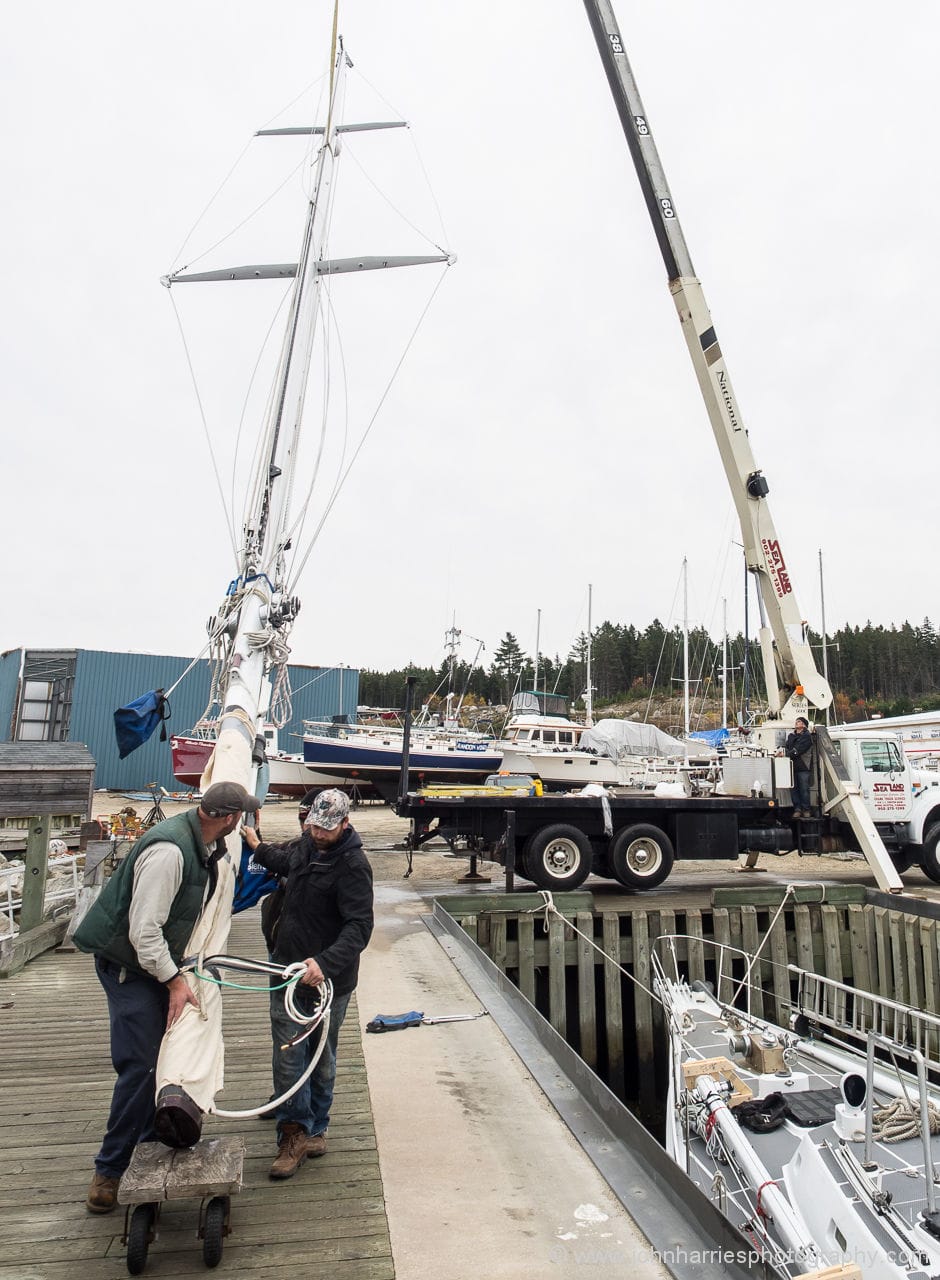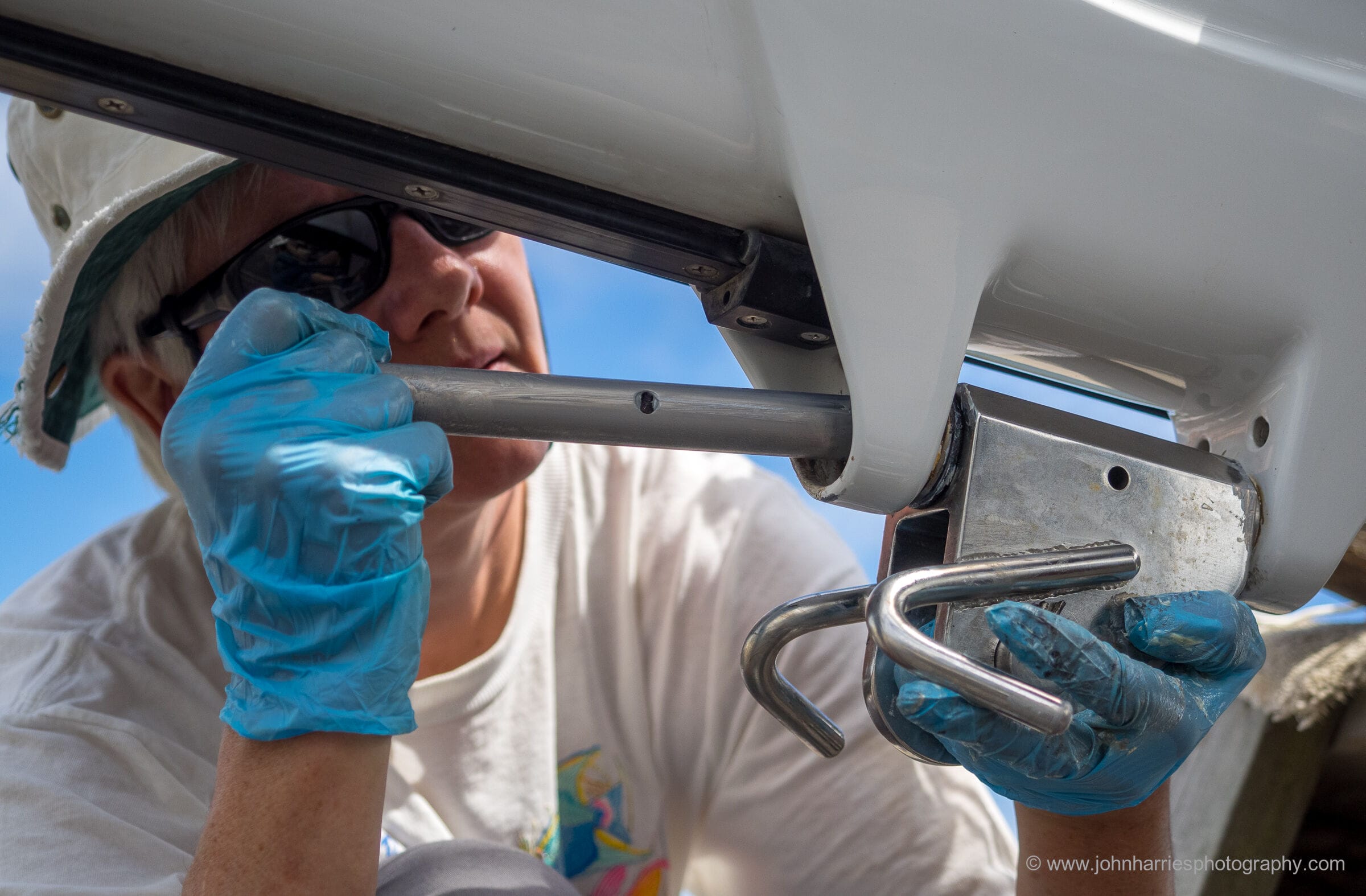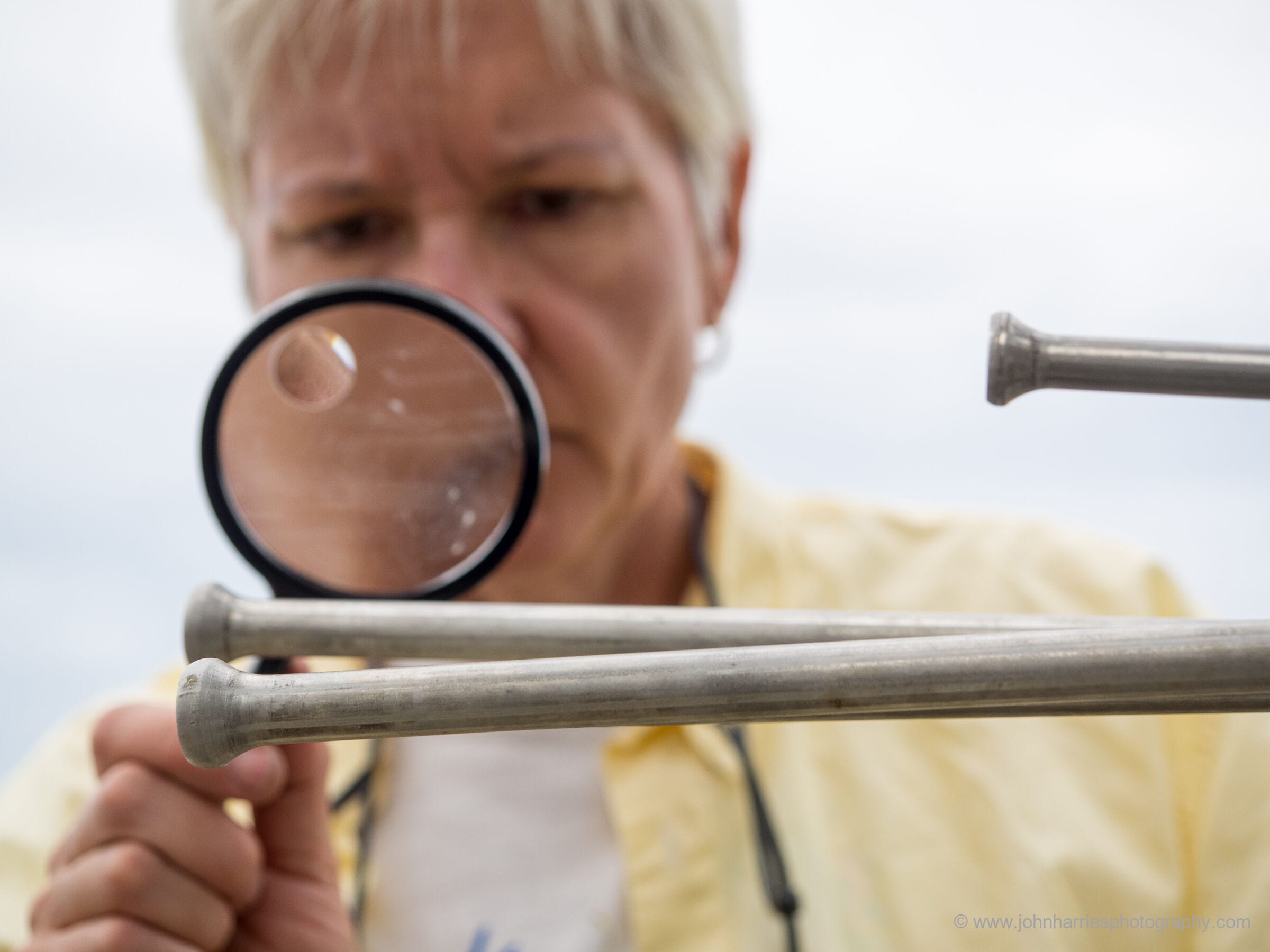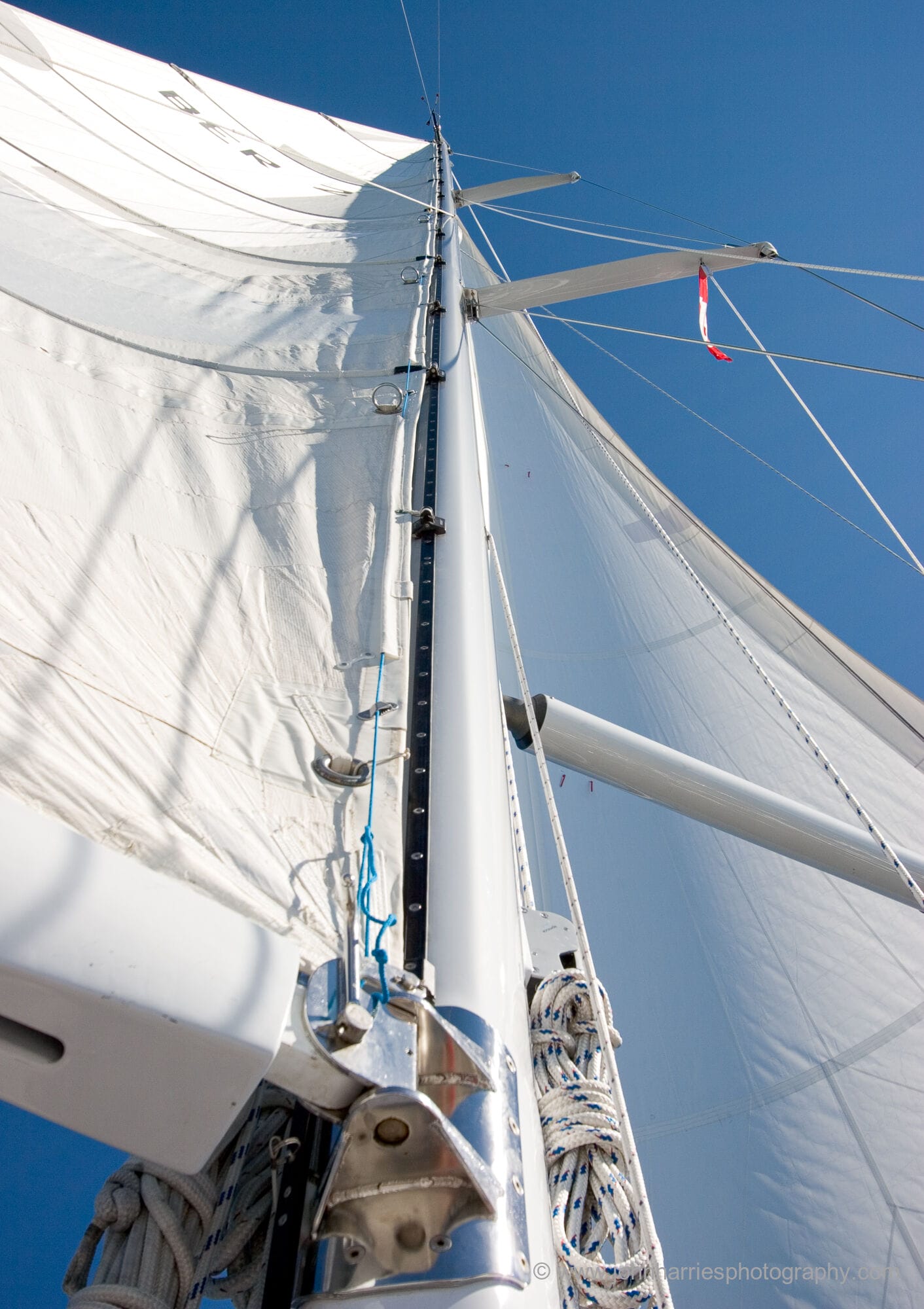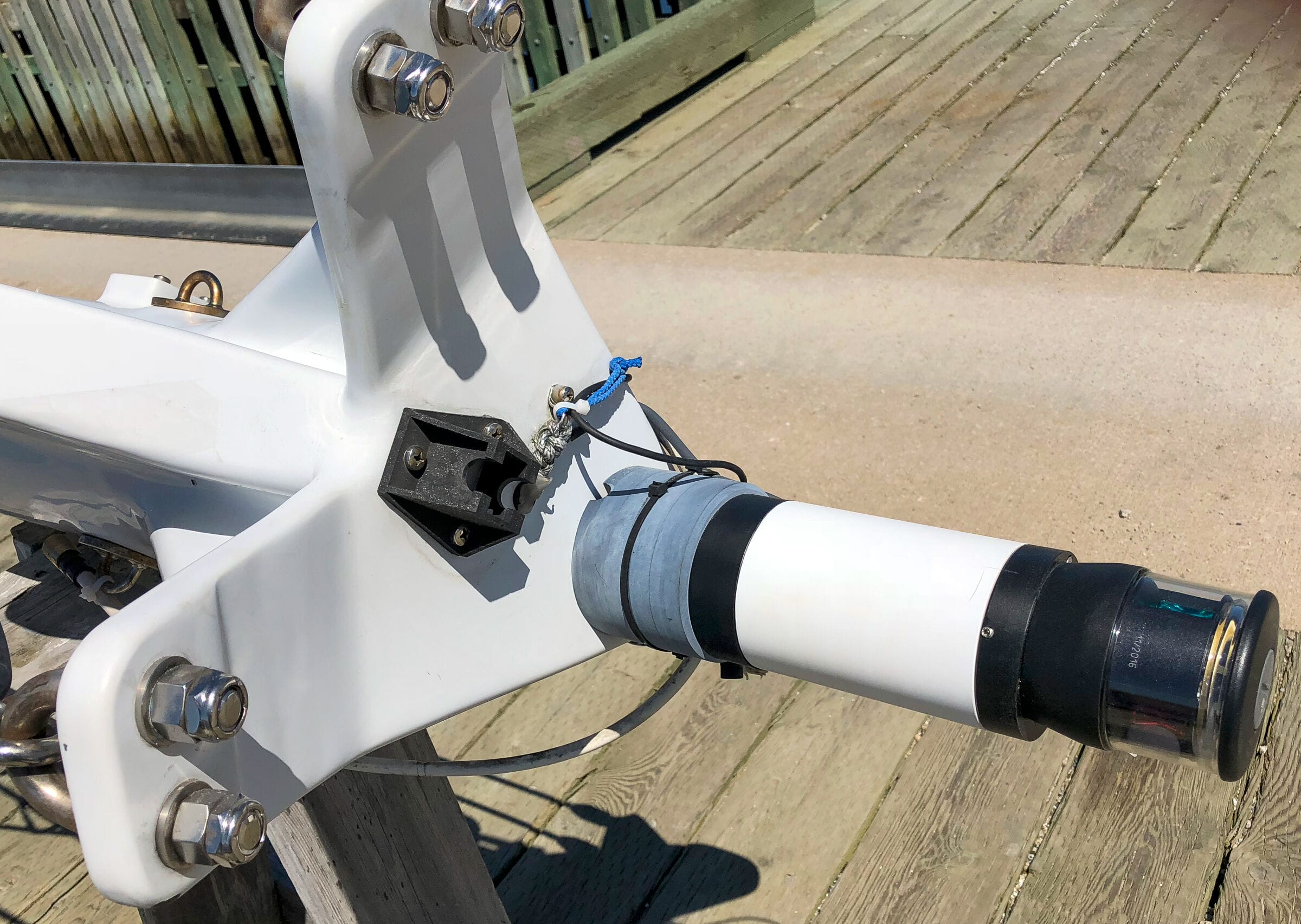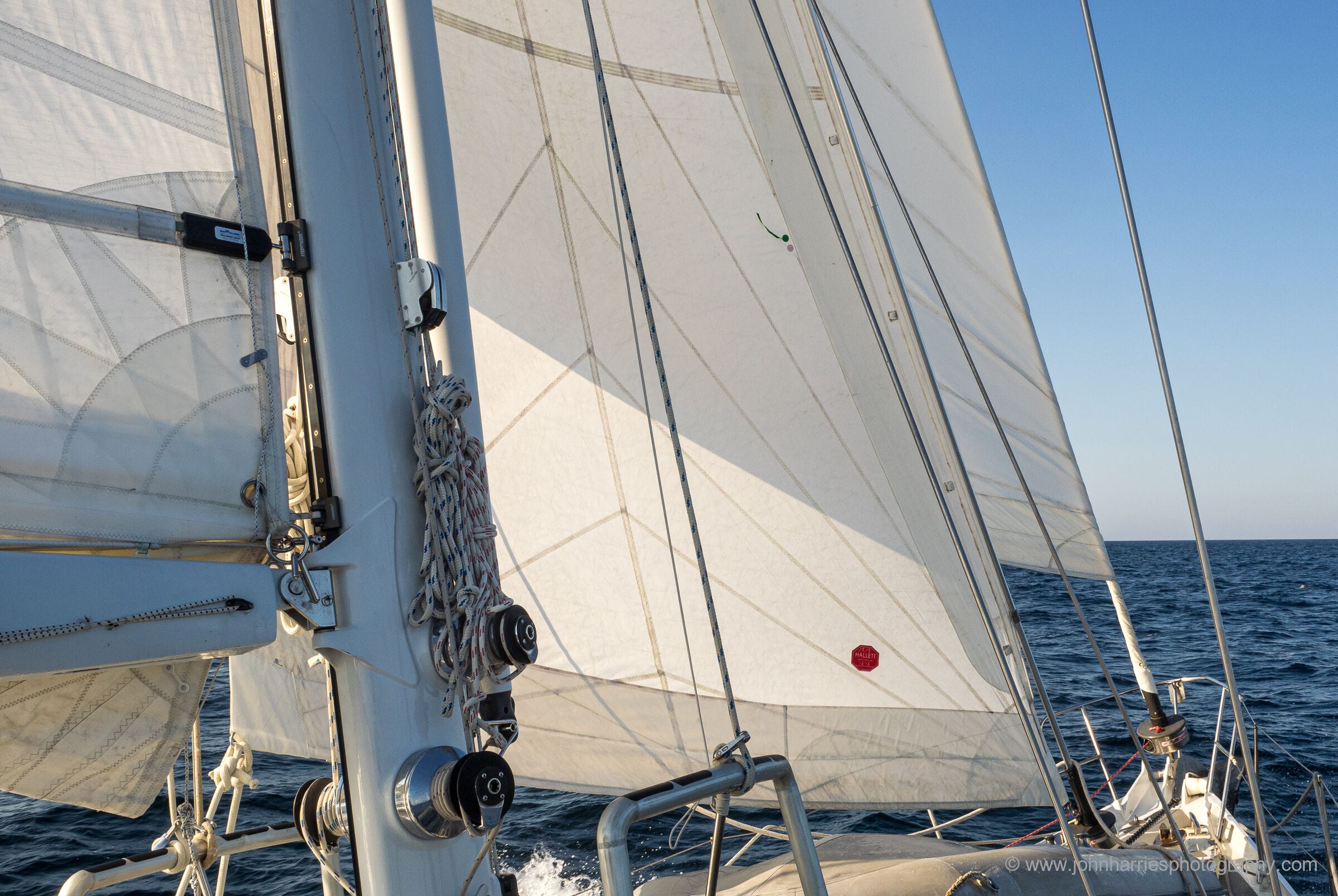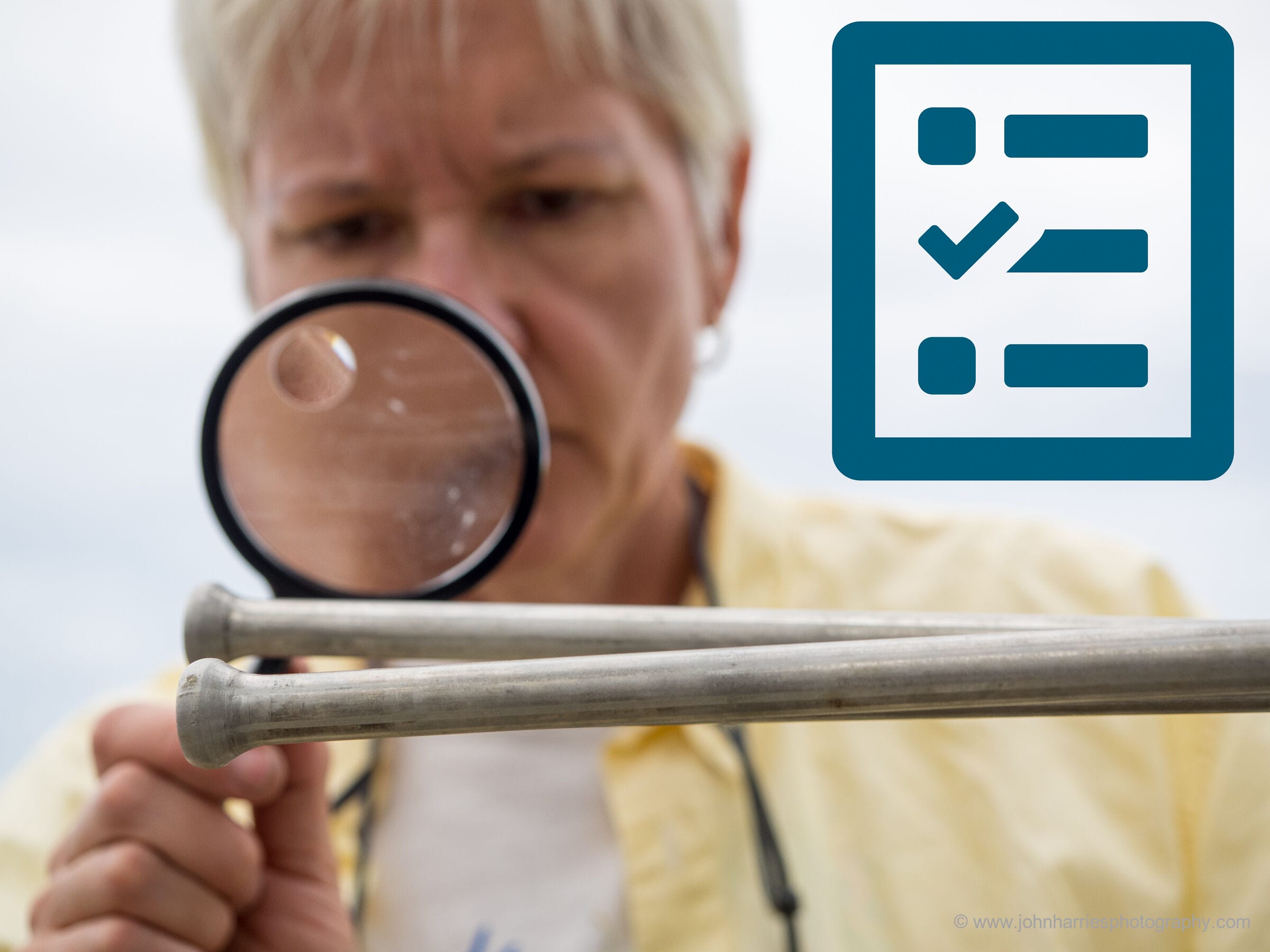The Offshore Voyaging Reference Site
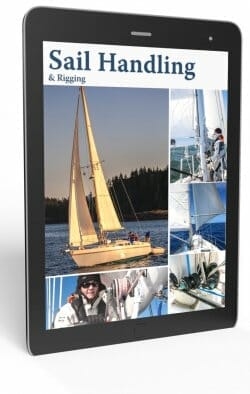
Online Book: Sail Handling and Rigging Made Easy
Setting, reefing and striking sails and doing it in challenging conditions—tips, techniques, gear, sail selection and trim as well as rigging and rig tuning.
Click for TOC or scroll down for details
Articles in this topic:
- Six Reasons To Leave The Cockpit Often
- Don’t Forget About The Sails
- Your Mainsail Is Your Friend
- Hoisting the Mainsail Made Easy—Simplicity in Action
- Reefs: How Many and How Deep
- Reefing Made Easy
- Reefing From The Cockpit 2.0—Thinking Things Through
- Reefing Questions and Answers
- A Dangerous Myth about Reefing
- Mainsail Handling Made Easy with Lazyjacks
- Topping Lift Tips and a Hack
- 12 Reasons The Cutter Is A Great Offshore Voyaging Rig
- Cutter Rig—Should You Buy or Convert?
- Cutter Rig—Optimizing and/or Converting
- Cruising Rigs—Sloop, Cutter, or Solent?
- Sailboat Deck Layouts
- The Case For Roller-Furling Headsails
- UV Protection For Roller Furling Sails
- In-Mast, In-Boom, or Slab Reefing—Convenience and Reliability
- In-Mast, In-Boom, or Slab Reefing —Performance, Cost and Safety
- The Case For Hank On Headsails
- Making Life Easier—Roller Reefing/Furling
- Making Life Easier—Storm Jib
- Gennaker Furlers Come Of Age
- Swept-Back Spreaders—We Just Don’t Get It!
- Q&A: Staysail Stay: Roller Furling And Fixed Vs Hanks And Removable
- Rigid Vangs
- Rigging a Proper Preventer, Part 1
- Rigging a Proper Preventer—Part 2
- Amidships “Preventers”—A Bad Idea That Can Kill
- Keeping The Boom Under Control—Boom Brakes
- Downwind Sailing, Tips and Tricks
- Downwind Sailing—Poling Out The Jib
- Setting and Striking a Spinnaker Made Easy and Safe
- Ten Tips To Fix Weather Helm
- Running Rigging Recommendations—Part 1
- Running Rigging Recommendations—Part 2
- Two Dangerous Rigging Mistakes
- Rig Tuning, Part 1—Preparation
- Rig Tuning, Part 2—Understanding Rake and Bend
- Rig Tuning, Part 3—6 Steps to a Great Tune
- Rig Tuning, Part 4—Mast Blocking, Stay Tension, and Spreaders
- Rig Tuning, Part 5—Sailing Tune
- 12 Great Rigging Hacks
- 9 Tips To Make Unstepping a Sailboat Mast Easier
- Cruising Sailboat Spar Inspection
- Cruising Sailboat Standing Rigging Inspection
- Cruising Sailboat Running Rigging Inspection
- Cruising Sailboat Rig Wiring and Lighting Inspection
- Cruising Sailboat Roller Furler and Track Inspection
- Download Cruising Sailboat Rig Checklist
-
Six Reasons To Leave The Cockpit Often
23 CommentsReading Time: 6 minutesMembersRead more: Six Reasons To Leave The Cockpit OftenStaying in the cockpit of a sailboat most of the time at sea and not getting out on deck often is not a good idea or safe.
-
Don’t Forget About The Sails
8 CommentsReading Time: 2 minutesMembersRead more: Don’t Forget About The SailsThese days, with all the focus on the latest whiz-bang gadgets, many sailors are forgetting to think about and spend money on their boat’s primary means of locomotion. In this post we look at why spending time and money on good sails is vital. Not only is a boat that sails well more fun, it’s also a lot safer.
-
Your Mainsail Is Your Friend
62 CommentsReading Time: 4 minutesMembersRead more: Your Mainsail Is Your FriendMany sailors have de-emphasized their mainsails, in some cases to the point where the main is the first sail to come down when the going gets tough and often does not even get set in the first place. This is a mistake and potentially dangerous.
-
Hoisting the Mainsail Made Easy—Simplicity in Action
85 CommentsReading Time: 4 minutesMembersRead more: Hoisting the Mainsail Made Easy—Simplicity in ActionWhen we have a problem on our boats, it’s always tempting to try to fix it by adding gear, but often a better approach is simplification. We look at mainsail hoisting as an example and provide several tips to make the job easier.
-
Reefs: How Many and How Deep
56 CommentsReading Time: 9 minutesMembersRead more: Reefs: How Many and How DeepSeveral members have asked for a post on how many reefs are optimal. But the answer is deeper (ouch) than that.
-
Reefing Made Easy
103 CommentsReading Time: 5 minutesFreeRead more: Reefing Made EasyHow to reef a sailboat easily and quickly without getting frightened or wet.
-
Reefing From The Cockpit 2.0—Thinking Things Through
85 CommentsReading Time: 7 minutesMembersRead more: Reefing From The Cockpit 2.0—Thinking Things ThroughIf you want to reef from the cockpit, you have to do it right. Colin shares how.
-
Reefing Questions and Answers
8 CommentsReading Time: 3 minutesMembersRead more: Reefing Questions and AnswersReefing is one of those areas where the devil really is in the details. Over the years we have answered dozens of questions about reefing. In this chapter we highlight a few of those and provide our answers.
-
A Dangerous Myth about Reefing
26 CommentsReading Time: 4 minutesMembersRead more: A Dangerous Myth about ReefingThere are probably more myths and downright wrong recommendations published about reefing than any other subject. In this chapter John exposes one of them and then goes on to explain how to do it right.
-
Mainsail Handling Made Easy with Lazyjacks
75 CommentsReading Time: 8 minutesMembersRead more: Mainsail Handling Made Easy with LazyjacksJohn believes that any boat over about 45 feet that will be sailed shorthanded needs lazyjacks. In this chapter he describes the lazyjack system that allows him to set, reef, and strike Morgan’s Cloud’s 600-square foot mainsail without resorting to complex gear like roller furling masts or booms.
-
Topping Lift Tips and a Hack
59 CommentsReading Time: 5 minutesMembersRead more: Topping Lift Tips and a HackDo you need a topping lift? John shares how to decide, and how to rig it if so, as well as a cool hack to reduce topping lift related chafe and noise at sea.
-
12 Reasons The Cutter Is A Great Offshore Voyaging Rig
70 CommentsReading Time: 9 minutesMembersRead more: 12 Reasons The Cutter Is A Great Offshore Voyaging Rig12 reasons that the true cutter is simply the best rig for short-handed offshore voyaging. And even if you don’t have a cutter, this chapter can help you make your boat easier to sail and faster too.
-
Cutter Rig—Should You Buy or Convert?
40 CommentsReading Time: 3 minutesMembersRead more: Cutter Rig—Should You Buy or Convert?When does the cutter rig make sense, both when buying a new boat and considering a conversion? We have a simple decision-tree to make things simple.
-
Cutter Rig—Optimizing and/or Converting
112 CommentsReading Time: 9 minutesMembersRead more: Cutter Rig—Optimizing and/or ConvertingNow we get to the nitty gritty: How to convert your boat to a cutter rig and how to make existing cutters better.
-
Cruising Rigs—Sloop, Cutter, or Solent?
77 CommentsReading Time: 11 minutesMembersRead more: Cruising Rigs—Sloop, Cutter, or Solent?Which of the three common cruising rigs is best? Like so many things around voyaging, all three have advantages and drawbacks. John takes a deep dive that will help you pick the one that’s right for your needs and then shares his two favourites, one for offshore and one for inshore.
-
Sailboat Deck Layouts
49 CommentsReading Time: 10 minutesMembersRead more: Sailboat Deck LayoutsIt’s amazing how few cruising boats actually have a good deck layout that makes them easy and fun to sail. John uses the Outbound 46 as an example of sail handling features he likes, and a few he doesn’t.
-
The Case For Roller-Furling Headsails
46 CommentsReading Time: 5 minutesMembersRead more: The Case For Roller-Furling HeadsailsRoller furling headsails are ubiquitous, but they are not without their drawbacks. John looks at ways to deal with that and make roller furling work well at sea.
-
UV Protection For Roller Furling Sails
38 CommentsReading Time: 4 minutesMembersRead more: UV Protection For Roller Furling SailsA headsail that is not protected from sun damage when furled, will only last a season or so. So what’s the best way to protect the sail? John has some suggestions.
-
In-Mast, In-Boom, or Slab Reefing—Convenience and Reliability
46 CommentsReading Time: 8 minutesMembersRead more: In-Mast, In-Boom, or Slab Reefing—Convenience and ReliabilityPart 1 of buyer’s guide examining the trade-offs between the three ways to set, strike and furl a mainsail on an offshore cruising boat.
-
In-Mast, In-Boom, or Slab Reefing —Performance, Cost and Safety
56 CommentsReading Time: 11 minutesMembersRead more: In-Mast, In-Boom, or Slab Reefing —Performance, Cost and SafetyPart 2 of a buyer’s guide examining the trade-offs between the three ways to set, strike and furl a mainsail on an offshore cruising boat.
-
The Case For Hank On Headsails
80 CommentsReading Time: 5 minutesMembersRead more: The Case For Hank On HeadsailsIt’s rare these days to see a cruising boat with hank-on headsails. But are such sails only for the traditionalists stuck in the stone age of offshore sailing? Maybe not. Here is a convincing case for hank-on sails, at least on smaller boats.
-
Making Life Easier—Roller Reefing/Furling
10 CommentsReading Time: 4 minutesMembersRead more: Making Life Easier—Roller Reefing/FurlingColin shares the details on the Harken roller reefing system they installed on their OVNI 435.
-
Making Life Easier—Storm Jib
23 CommentsReading Time: 5 minutesMembersRead more: Making Life Easier—Storm JibColin and Louise carry a dedicated hanked on storm jib ready to go when necessary. Colin tells us why and how.
-
Gennaker Furlers Come Of Age
3 CommentsReading Time: 3 minutesMembersRead more: Gennaker Furlers Come Of AgeA recent article in French sailing magazine Voiles et Voiliers looked at 7 different gennaker furlers, both for ease of use and ability to handle heavy loads. The results are surprising.
-
Swept-Back Spreaders—We Just Don’t Get It!
0 CommentsReading Time: 2 minutesMembersRead more: Swept-Back Spreaders—We Just Don’t Get It!John doesn’t understand the move to swept back spreaders in sailboat rig design. And he’s not shy about saying so.
-
Q&A: Staysail Stay: Roller Furling And Fixed Vs Hanks And Removable
6 CommentsReading Time: 2 minutesMembersRead more: Q&A: Staysail Stay: Roller Furling And Fixed Vs Hanks And RemovableWhich is better for the staysail stay? Roller furling and fixed or hanks and removable? John says it depends.
-
Rigid Vangs
62 CommentsReading Time: 10 minutesMembersRead more: Rigid VangsRigid vangs were once only seen on racing sailboats, but cruisers can benefit, too. John explains why, how to choose between the two types (mechanical and hydraulic), as well as how to fit and use one safely.
-
Rigging a Proper Preventer, Part 1
57 CommentsReading Time: 7 minutesMembersRead more: Rigging a Proper Preventer, Part 1A head injury is a terrible event wherever you are, but at sea far from medical help it’s even worse. Rigging a proper preventer is one of the surest ways to reduce the risk to you and your crew. In part 1 of this two part series we look at the risk and what constitutes a proper preventer.
-
Rigging a Proper Preventer—Part 2
130 CommentsReading Time: 8 minutesMembersRead more: Rigging a Proper Preventer—Part 2Part 2 of my article on preventers. In Part 1 I explained why a proper preventer is vital and in this part I share how to make rigging one easy and safe.
-
Amidships “Preventers”—A Bad Idea That Can Kill
78 CommentsReading Time: 5 minutesMembersRead more: Amidships “Preventers”—A Bad Idea That Can KillJohn has long advocated for preventers rigged from the boom well outboard to the bow as the only right way. We now have solid engineering, and a tragedy, to show how important this is.
-
Keeping The Boom Under Control—Boom Brakes
10 CommentsReading Time: 3 minutesMembersRead more: Keeping The Boom Under Control—Boom BrakesIn the last two chapters we covered preventers. But what about controlling the boom once the wind comes forward and also slowing things down when gybing? Colin has the answer.
-
Downwind Sailing, Tips and Tricks
42 CommentsReading Time: 8 minutesMembersRead more: Downwind Sailing, Tips and TricksColin draws on his decades of experience racing and cruising to share some tips and tricks that will make reaching and downwind sailing faster and more comfortable. Chapter FREE to view for three days.
-
Downwind Sailing—Poling Out The Jib
113 CommentsReading Time: 12 minutesMembersRead more: Downwind Sailing—Poling Out The JibPoling out the headsail to sail downwind can be intimidating, particularly offshore in big breeze, but Colin has a way to make it easy and safe.
-
Setting and Striking a Spinnaker Made Easy and Safe
119 CommentsReading Time: 11 minutesMembersRead more: Setting and Striking a Spinnaker Made Easy and SafeSome of the most fun and satisfying sailing we can do is under asymmetric spinnaker. Here’s how to set and strike one safely with a sock, even offshore and in big breeze.
-
Ten Tips To Fix Weather Helm
62 CommentsReading Time: 7 minutesMembersRead more: Ten Tips To Fix Weather HelmThere are few problems that detract more from the pleasure of sailing than a bad case of weather helm, a surprisingly common affliction. The good news is that this problem can be fixed.
-
Running Rigging Recommendations—Part 1
53 CommentsReading Time: 9 minutesMembersRead more: Running Rigging Recommendations—Part 1Detailed recommendations, including brand names, for running rigging for cruising sailboats.
-
Running Rigging Recommendations—Part 2
54 CommentsReading Time: 8 minutesMembersRead more: Running Rigging Recommendations—Part 2How to select the right rope diameters, attach sheets and halyards to sails the right way, and keep chafe from ruining your day.
-
Two Dangerous Rigging Mistakes
41 CommentsReading Time: 5 minutesMembersRead more: Two Dangerous Rigging MistakesThe loads on a modern offshore cruising boat are substantial so we sailors need to really think about how we handle them. John discusses two common mistakes and what we can all learn from them.
-
Rig Tuning, Part 1—Preparation
47 CommentsReading Time: 9 minutesMembersRead more: Rig Tuning, Part 1—PreparationGetting the rig properly tuned is vital for any sailboat, but it’s not easy to do right. John takes the mystery out of the process with a step-by-step procedure that works.
-
Rig Tuning, Part 2—Understanding Rake and Bend
9 CommentsReading Time: 8 minutesMembersRead more: Rig Tuning, Part 2—Understanding Rake and BendIn Part 1 we got the mast upright in the athwartship plane so it was not leaning over to one side or the other. Now let’s set the fore and aft rake and bend. But before we set off on that long and winding road we need to make sure we know what the destination is, and that’s what this chapter is about.
-
Rig Tuning, Part 3—6 Steps to a Great Tune
12 CommentsReading Time: 9 minutesMembersRead more: Rig Tuning, Part 3—6 Steps to a Great TuneJohn bored you to death with a lot of mast tuning theory in the last chapter, but here’s the pay off: a step-by-step guide that will yield a good tune every time.
-
Rig Tuning, Part 4—Mast Blocking, Stay Tension, and Spreaders
55 CommentsReading Time: 10 minutesMembersRead more: Rig Tuning, Part 4—Mast Blocking, Stay Tension, and SpreadersSetting up a rig to be safe and functional offshore is all about getting the details right. Here are some vital things to know and do.
-
Rig Tuning, Part 5—Sailing Tune
15 CommentsReading Time: 9 minutesMembersRead more: Rig Tuning, Part 5—Sailing TuneIn the previous four parts of this series on mast tuning, we got all the basics taken care of, now we just need to go sailing to complete a great tune.
-
12 Great Rigging Hacks
51 CommentsReading Time: 11 minutesMembersRead more: 12 Great Rigging HacksJohn puts his lazy streak on display with five rigging hacks to do less work, but still do things right.
-
9 Tips To Make Unstepping a Sailboat Mast Easier
11 CommentsReading Time: 5 minutesMembersRead more: 9 Tips To Make Unstepping a Sailboat Mast EasierUnstepping the mast is one of the most stressful tasks we sailboat owner’s face, but here are some tips to make it a lot easier.
-
Cruising Sailboat Spar Inspection
43 CommentsReading Time: 10 minutesMembersRead more: Cruising Sailboat Spar InspectionDismastings are dangerous voyage enders for cruising boats. Doing this inspection of spars, steps and chainplates will reduce the risk substantially.
-
Cruising Sailboat Standing Rigging Inspection
39 CommentsReading Time: 12 minutesMembersRead more: Cruising Sailboat Standing Rigging InspectionInspection tips and recommended replacement cycles for offshore cruising boat standing rigging, hydraulics, and vangs.
-
Cruising Sailboat Running Rigging Inspection
18 CommentsReading Time: 10 minutesMembersRead more: Cruising Sailboat Running Rigging InspectionInspection, repair tips and replacement cycles for offshore cruising boat running rigging.
-
Cruising Sailboat Rig Wiring and Lighting Inspection
52 CommentsReading Time: 9 minutesMembersRead more: Cruising Sailboat Rig Wiring and Lighting InspectionInspection, repair, and replacement tips for mast navigation lights, wind indicators, and lightning protection systems.
-
Cruising Sailboat Roller Furler and Track Inspection
22 CommentsReading Time: 10 minutesMembersRead more: Cruising Sailboat Roller Furler and Track InspectionModern sail-handling system have made offshore sailing safer and easier, but they also demand regular inspection and maintenance.
-
Download Cruising Sailboat Rig Checklist
4 CommentsReading Time: < 1 minuteMembersRead more: Download Cruising Sailboat Rig ChecklistThe rig checklist is ready for download and links to five articles of in depth inspection tips and advice on fixing the problems you find.

